Before we leave Valencia behind in our blog for good, I would be remiss if I didn’t cover some of the amazing sights and events we took in while we were there. After a couple of weeks of being in Spain, we were so focused (stressed) and bogged down fixing up the boat (we had several unexpected issues) that we realized we were both making ourselves crazy and not taking advantage of this amazing city and country we were living in. So, we instituted two rules; First, we would wrap up the day’s projects around 5pm no mater what and enjoy the rest of the evening relaxing. We treasured these nights hanging out on the top deck watching the sun go down and, at times, distant storms go by. Second, we decided Thursdays would be our “tourist” days. We would venture out other days when time allowed or if we just needed a break, but we made sure we had at least one day of fun planned. We’d find something fun to see or do in this foreign city and there was plenty of history and fun to be found! Here are some of our favorites should you ever venture to Valencia! It truly is a beautiful city with a very rich history.
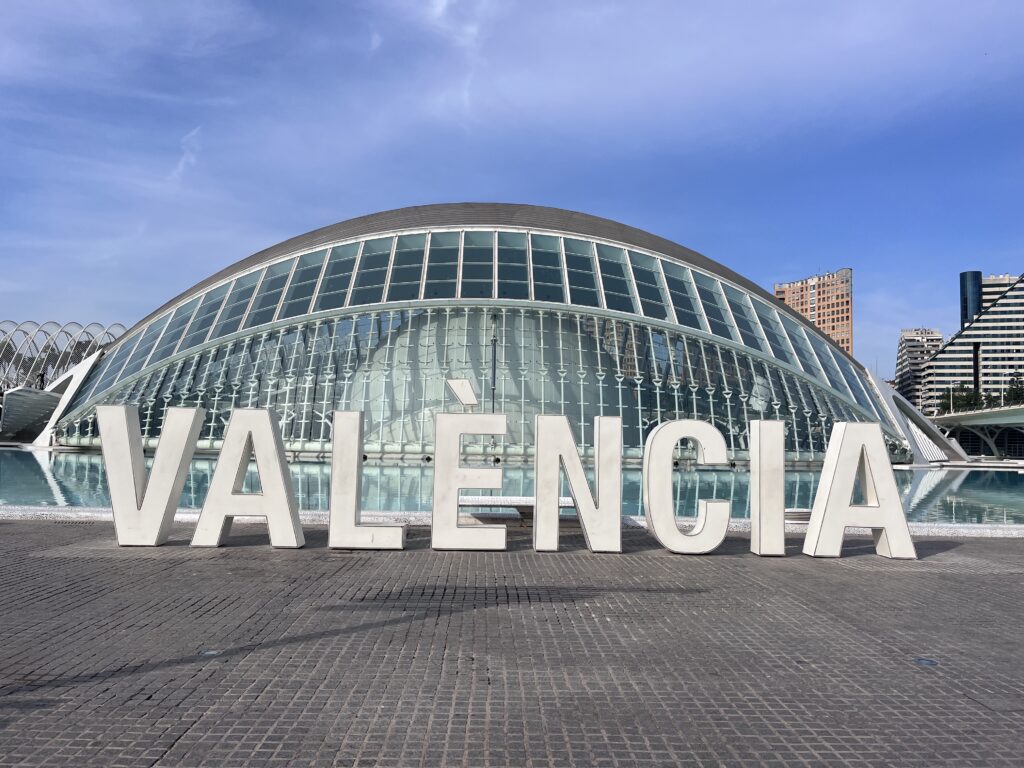
The city itself has such long history it is hard to fathom! Valencia was founded as a Roman colony in 138 BC. The city surrendered to the invading moors about 714 AD. Islamic rule and acculturation ensued in the 8th century until the Aragonese Christian conquest took place in 1238 when the city became the capital of the Kingdom of Valencia. The town really hit it’s” stride”Golden Age” during the Renaissance with in the 14th and 15th flourishing agriculture and maritime trades and surge in the arts. Moving around the city you see the influences of these different periods in the architecture and atmosphere all around you.
La Ciudad de las Artes y las Ciencias (City of Arts & Sciences)
If you are a fan of the HBO hit series WestWorld, you’ll recognize this amazing area from season 3. Developed in 1996 by Valencia architect Santiago Calatrava, the futuristically designed City of Arts and Sciences crosses 2 km of the dry Turia River bed. The river was diverted in the 1950s due to massive flooding issues it caused throughout the city.
The complex is made up of imposing large white concrete and glass structures surrounded by beautiful blue reflecting pools. The whole area is lined with a number of walking and biking paths, and gardens filling out the dried river bank.
At the southern end is the beautiful El Pont de l’Assut de l’Or suspension bridge, completed in 2008, that connects the south side with Minorca Street, whose 125 meters high pillar is the highest point in the city.
The buildings that make up the ‘city’ are:
L’Hemisfèric (beetle) – An IMAX cinema, planetarium and Laserium
L’Umbracle – Is the northern entrance to complex includes an elevated garden promenade you can walk through
El Palau de les Arts Reina Sofía (helmet) – An opera house and performing arts center
El Museu de les Ciéncies Principe Felipe – A science museum
Ágora – A versatile events space
Oceanografic – An open air aquarium
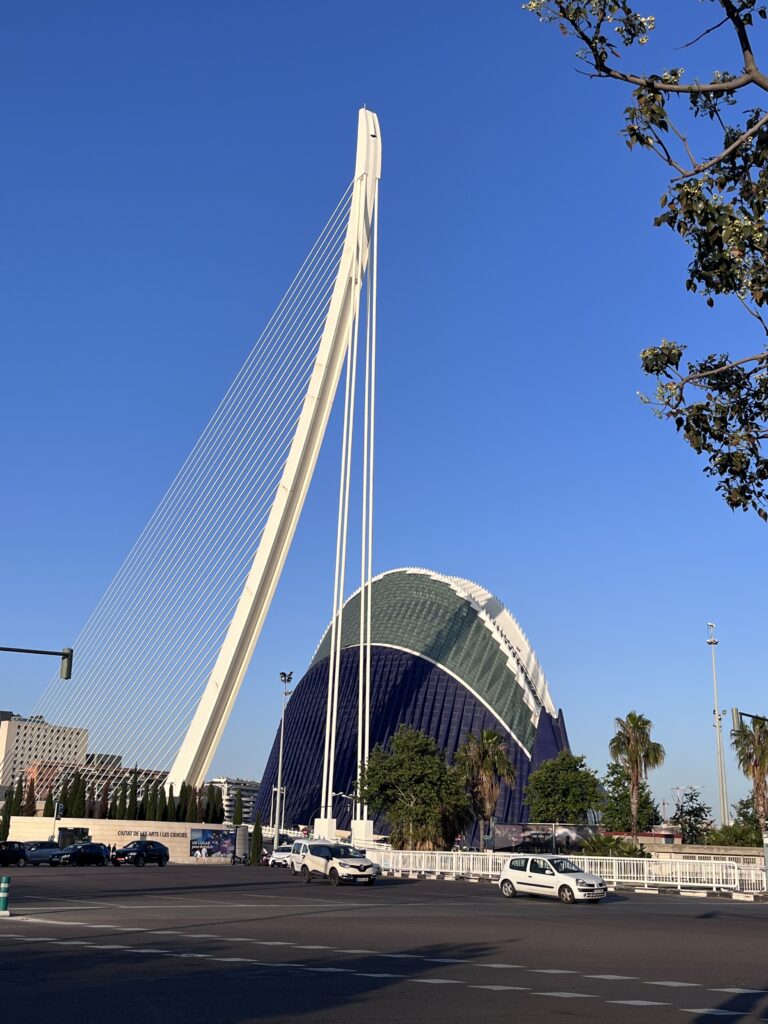
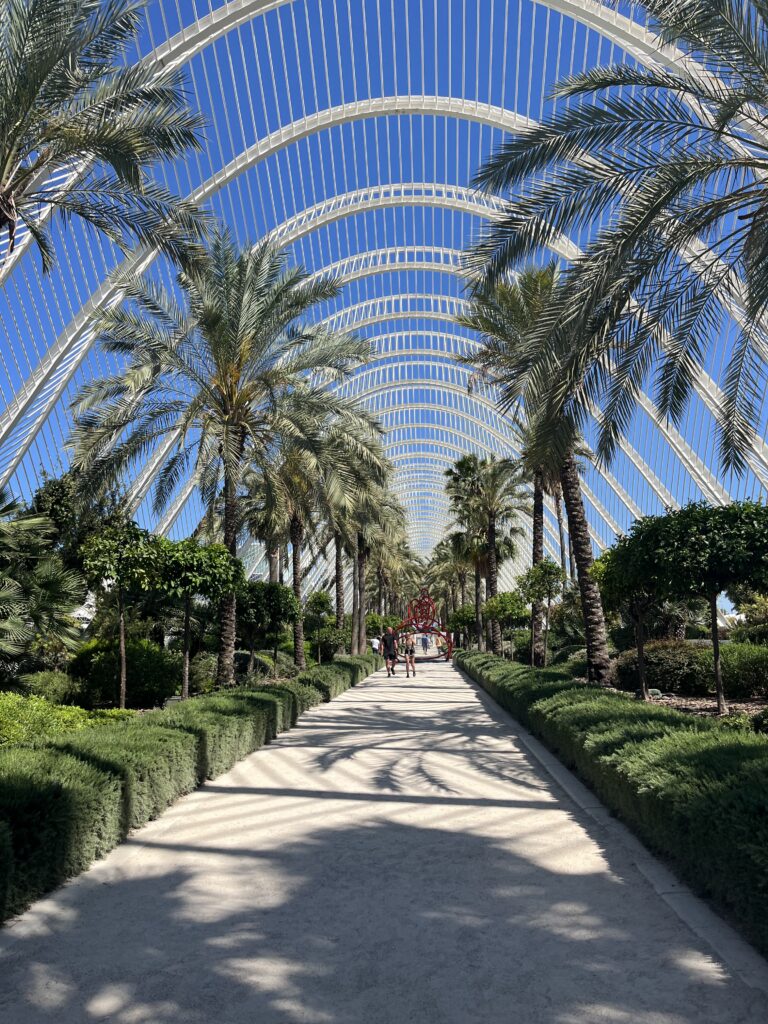
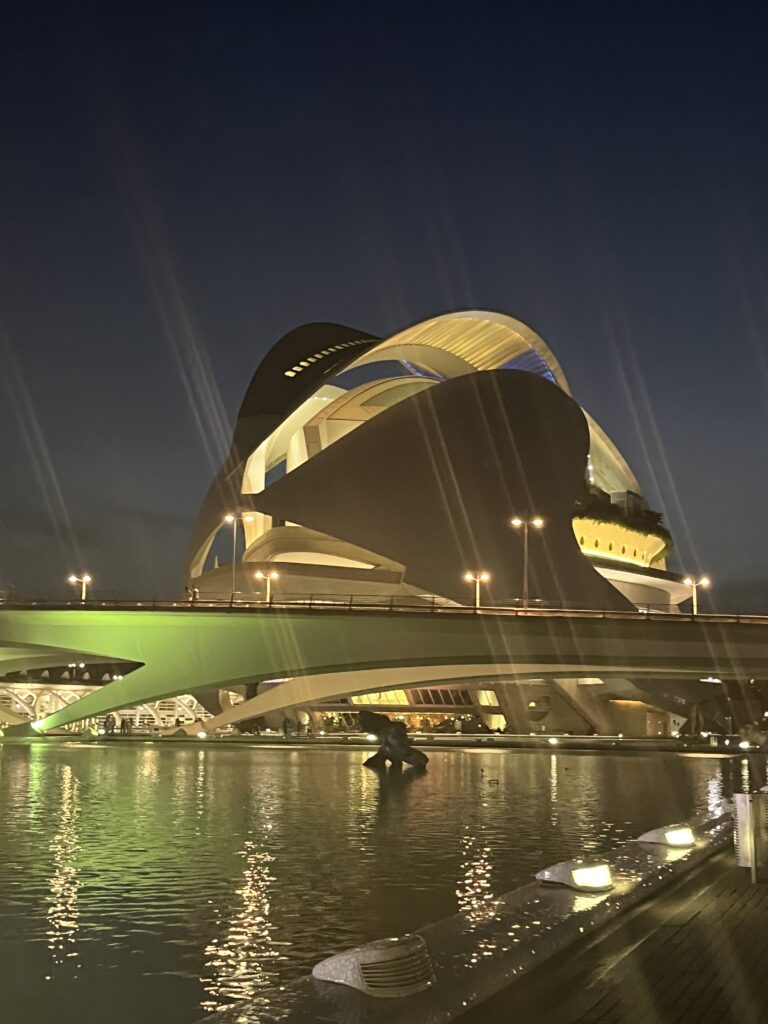
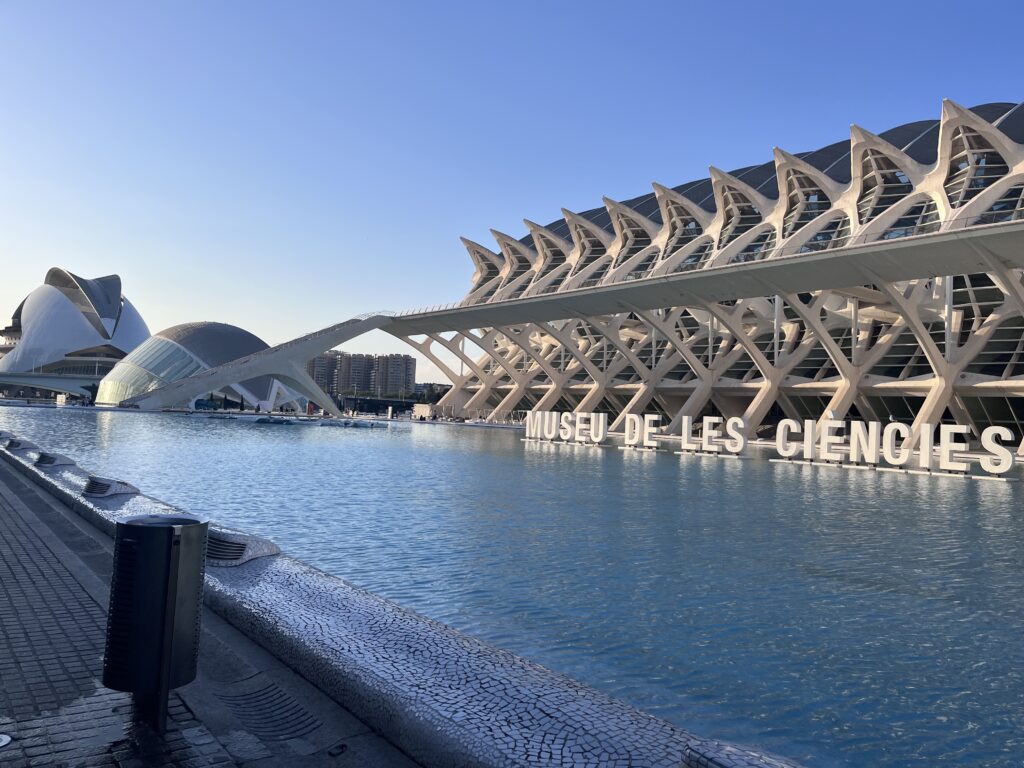
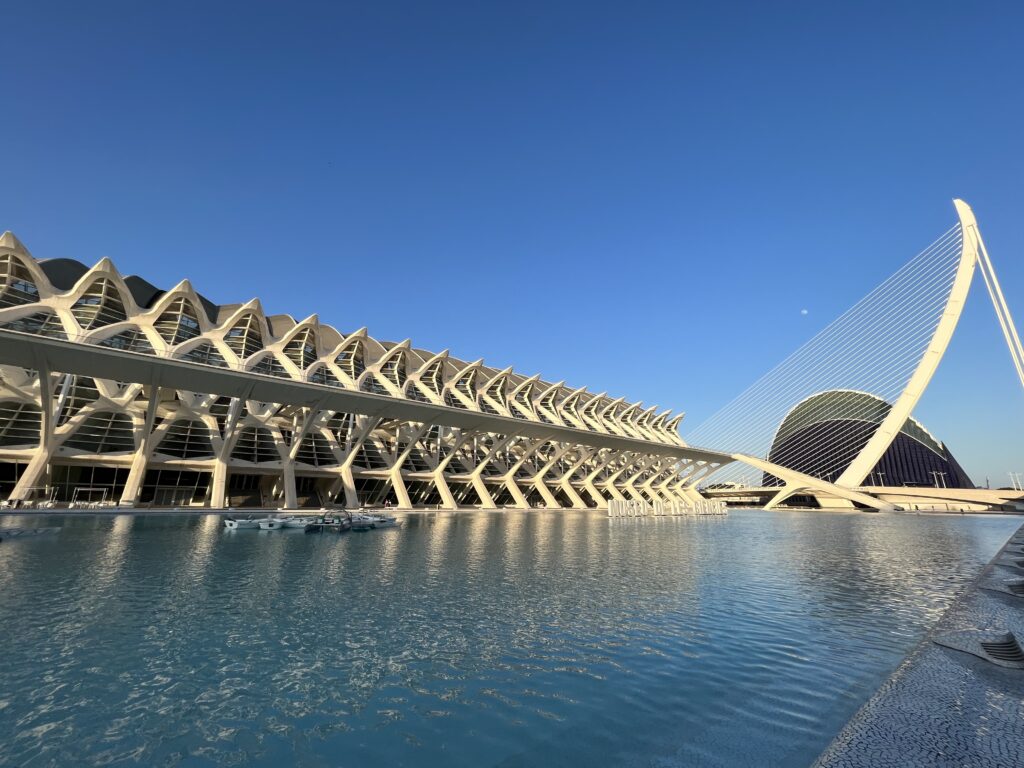
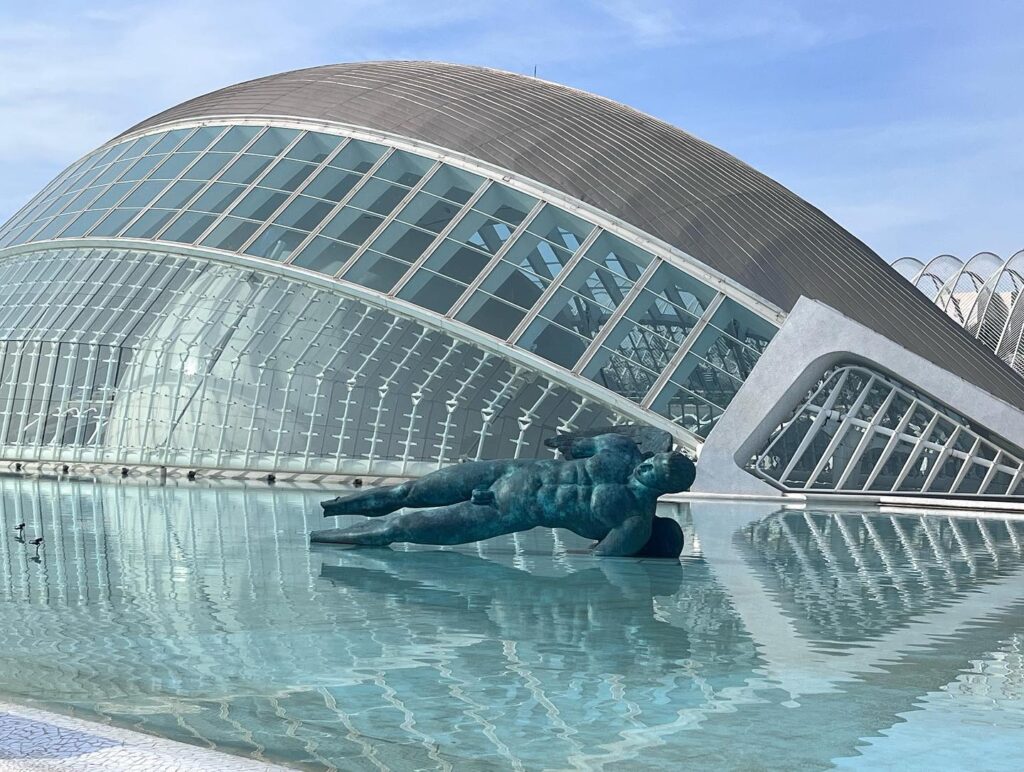
The only of these buildings we visited in depth was the Oceanographic open air aquarium.
Oceanographic
The Oceanogràfic Aquarium is the largest complex of its type in Europe and home to 45,000 animals from 500 different species all inhabiting 9 different two-tiered underwater towers (a lot of steps and ramps involved!) representing 15 different earth ecosystems. Additionally, it boasts one of the largest dolphinariums in the world (even if I found the show a bit lacking and surprisingly full of American music) and the longest underwater viewing tunnel in Europe. While not one of my favorite aquariums I’ve been to, it was certainly one of the most unique; and surprisingly affordable at 13 euros ($14 US)!
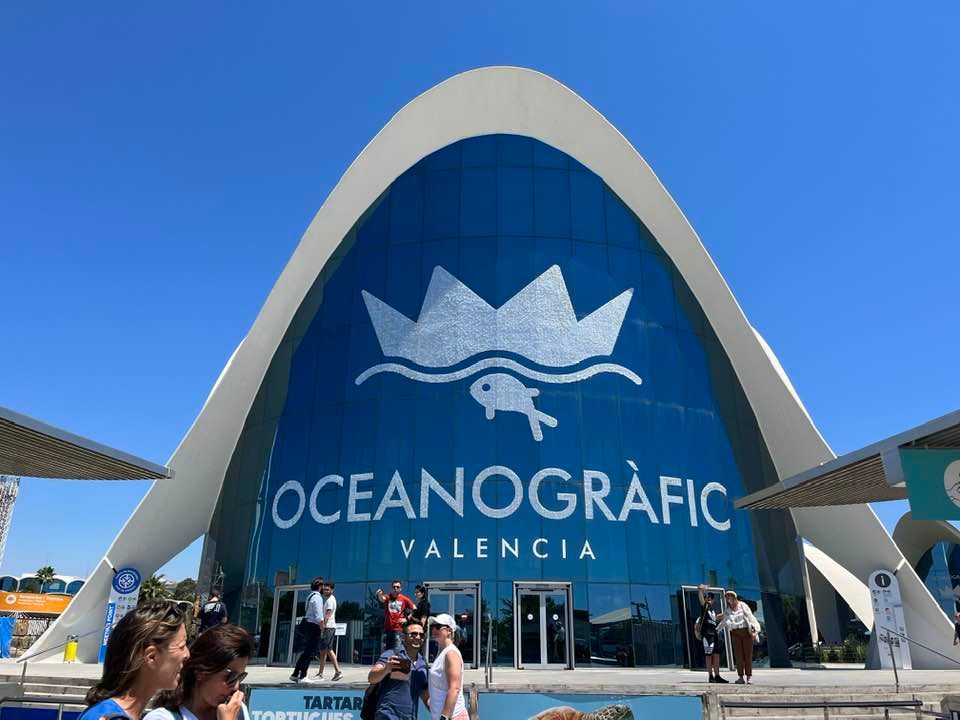
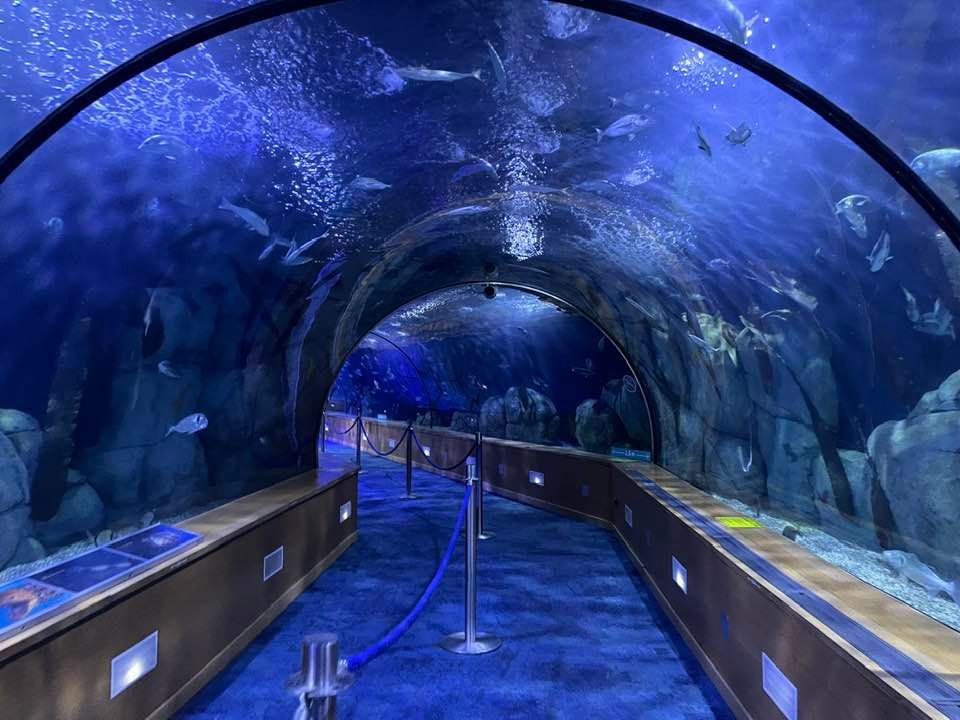
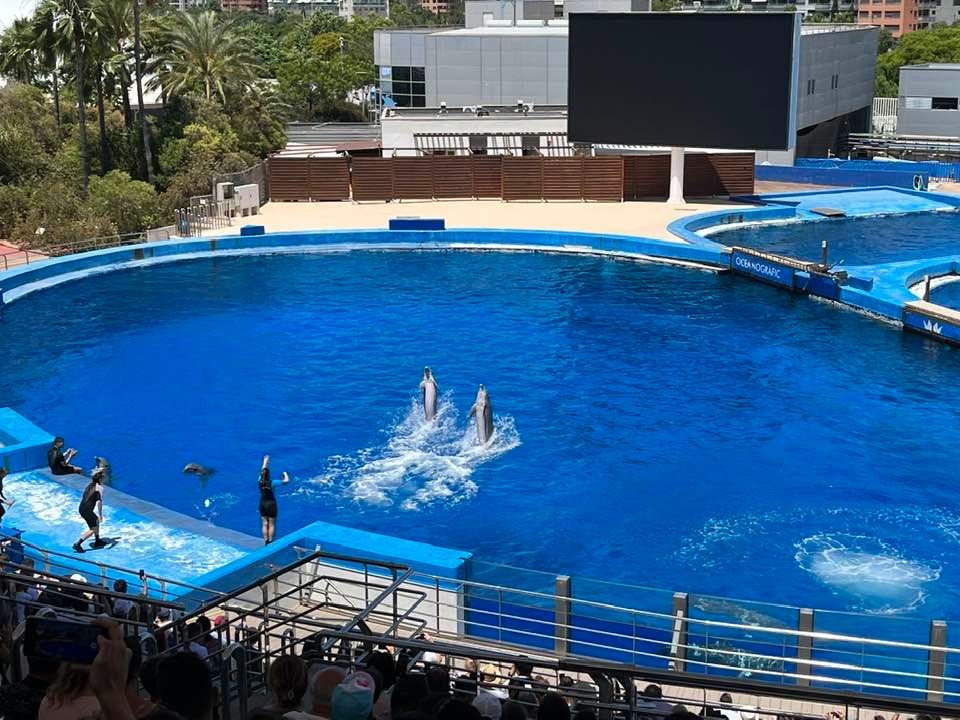
Jardins del Turia, or Turia Gardens
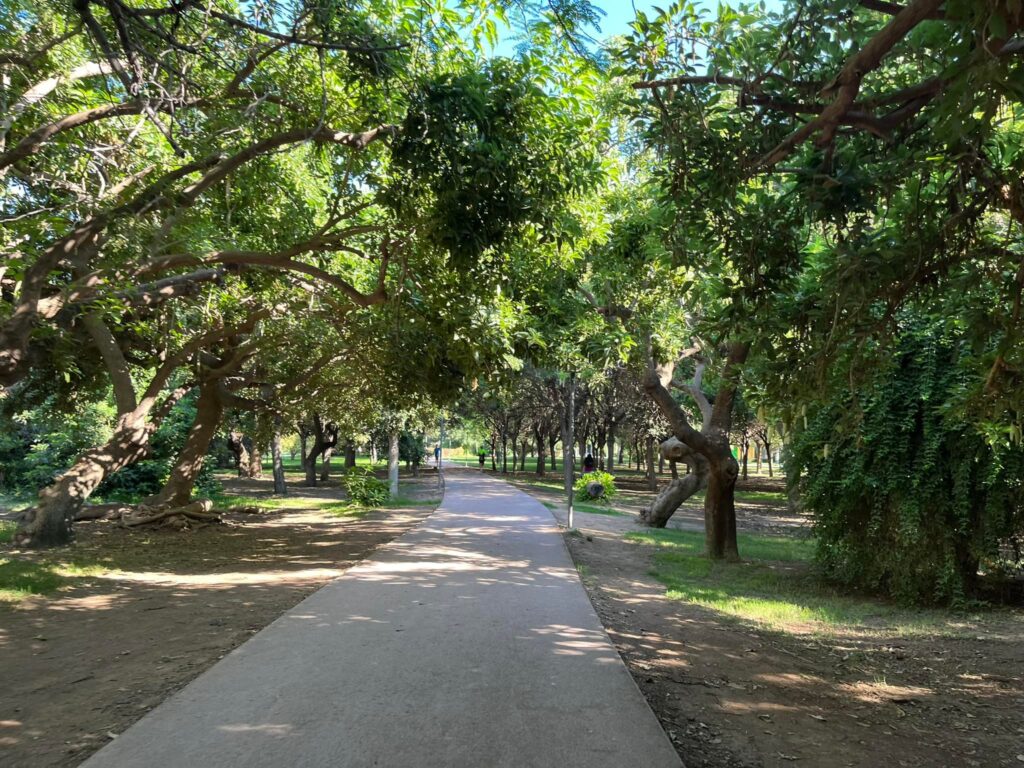
Continuing northwest along the walking and bike paths out of the Ciudad complex, you arrive at the beginning of one of the largest urban parks in Spain. A vast green space encompassing a number of walking/running/biking paths and sporting/leisure areas that stretches on for 9 kilometers along the former Turia River riverbed. Following a devastating flood in 1957, the Turia river’s course was diverted south of the city. Various urban planners worked together designing different parts of the park that now lies there.
The paths are criss-crossed by 18 bridges dating back to the 14-16th centuries and lined by many of Valencia’s museums and monuments. There are a number of signs along the trail written in Spanish, French and English that explain the history of the various bridges, buildings and park features you pass. It is quite literally traveling through history as you meander around the park.
Two of the oldest bridges you’ll cross under include the Puente Del Mar and Puente de San Jose (14th Century) bridges. The Puente Del Mar, a stone bridge built to replace older wooden versions, was built between 1592 and 1596 after the previous bridge was destroyed in the great Turia river flood of 1589. It is called the “sea bridge” because it was the route to the port area of El Grau. It was again destroyed in successive floods in the 1800s. Now the sculptures of Saint Pasqual Ballon (1943) and Our Lady of Forsaken (1946) stand over watch. The earliest known records of the San Jose Bridge date back to the 14th century.
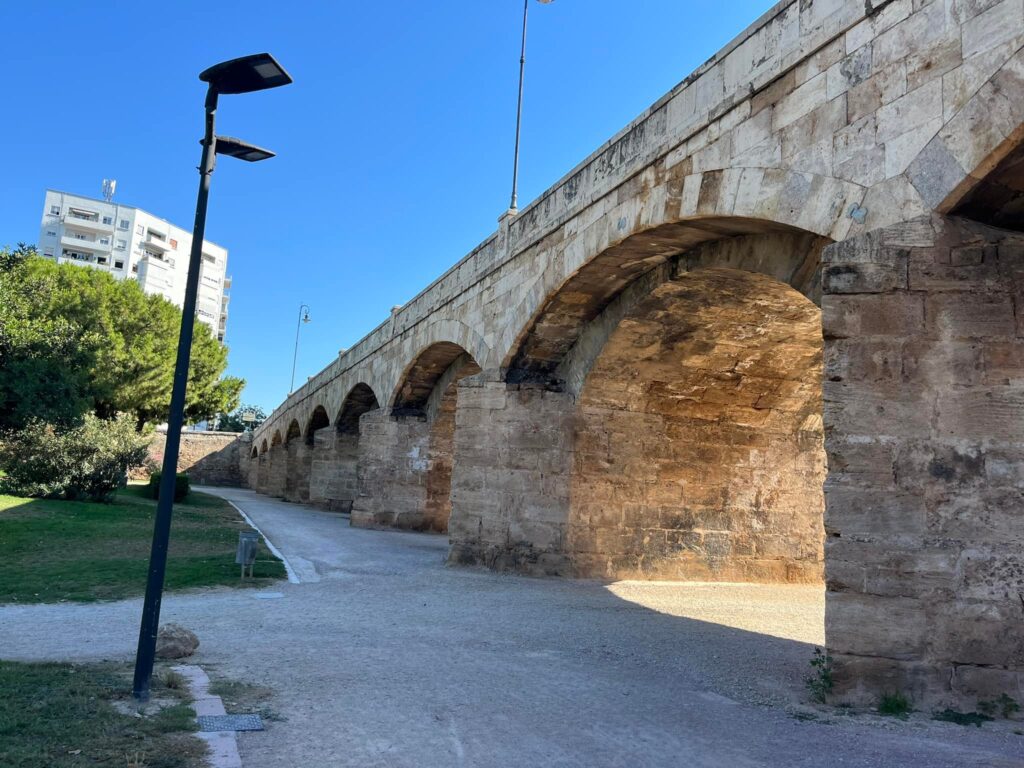
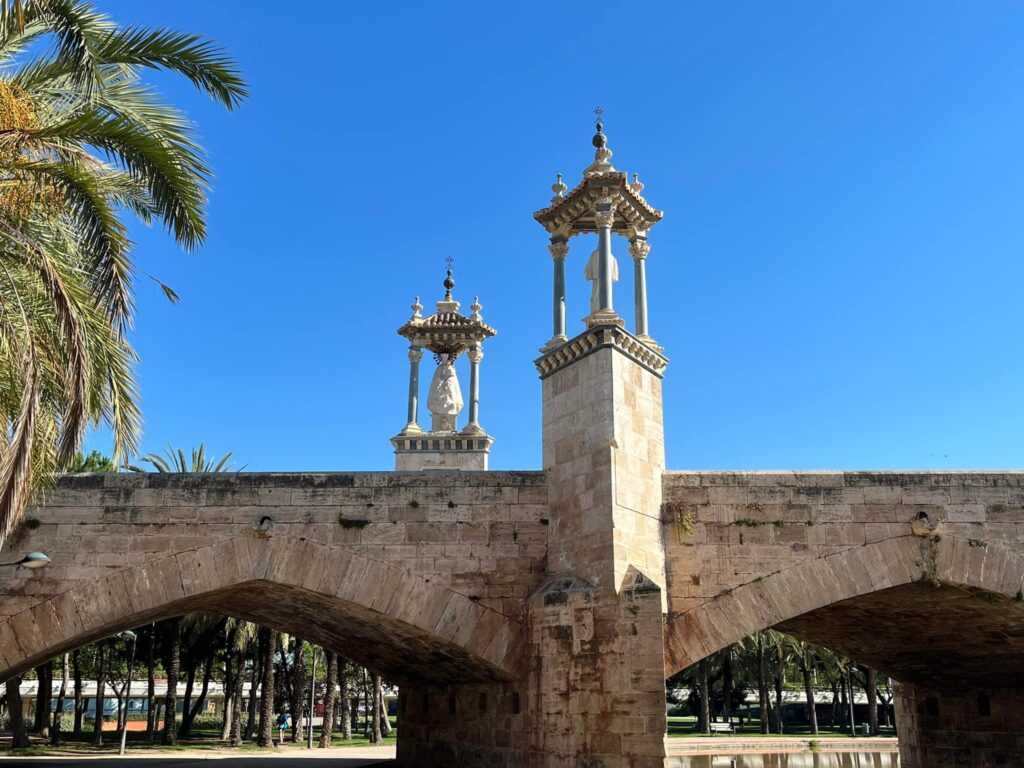
Some of the buildings you will spy in the distance include the Museu De Belles Arts Sant Pius V with it’s signature purple dome. And the, Puerto de Surranos (Surranos Towers), I’ll cover a little later.
The Sistine Chapel of Valencia
One of our first planned outings was supposed to be to the Valencia Cathedral, but it was temporarily closed due to renovations the first time we showed up. After walking a bit looking for something else to see, we stumbled upon the “Sistine Chapel of Valencia”. I’m glad this happened because I’m not sure I would have put the Church of San Nicolás de Bari y San Pedro Mártir on our agenda otherwise. It was incredible and quite overwhelming in decor. Erected in 1242 after the Christian conquest and offered by King James I to the Dominicans who accompanied him. It was remodeled several times with different styles like Valencian Gothic, Neo-Gothic, and Baroque creating a very majestic and mysterious atmosphere. It was in disrepair at the turn of the century, but recently restored from 2012 to 2016, and we can say all those frescoes have been restored to their colorful former glory.
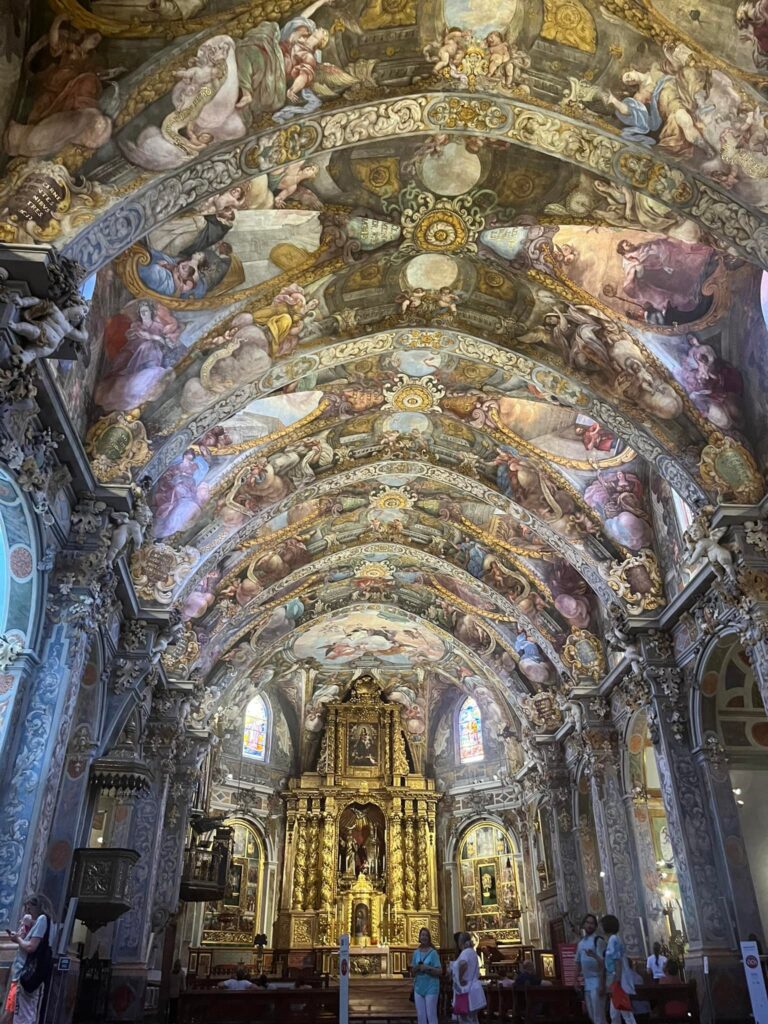
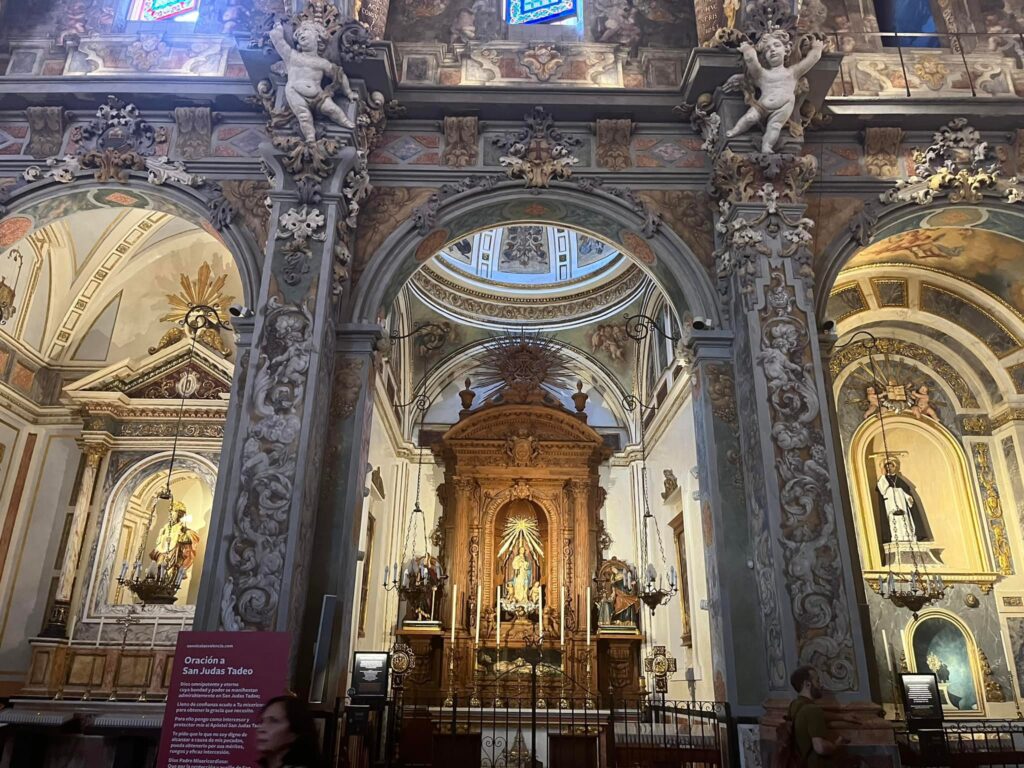
Valencia Cathedral
This was easily the building I was most excited to visit. The Metropolitan Cathedral – Basilica of the Assumption of Our Lady of Valencia. (St. Mary’s Cathedral), or more commonly known as the Valencia Cathedral, was consecrated in 1238 by the first bishop of Valencia. Construction of the Cathedral itself occurred over centuries and ultimately highlights the history of the city itself. which can be viewed in the various artistic styles of the building ranging from Romanesque, Valencian Gothic, Renaissance, Baroque and Neoclassical The underlying foundation was a Roman Temple dedicated to Jupiter around the 6th century. In the 8th Century it served as a mosque under the Moors until the Christians took over. Now, it is not only an amazing Cathedral, it is home to the Vatican recognized Holy Chalice. Religious or not, it’s incredible and worth a visit!
Some highlights of our visit there included:
The Valencia Cathedral Main Gate. Built in Baroque style during 1703 – 1741. The name of the Virgin Mary appears at the top of the iron gate.
The Apostle Doors on the back side– note there are no hands or arms on the sculptures surrounding the gate. The material used was sand and due to the humidity in the city, they are unable to maintain the detail.
Also fun note: Outside these doors is where the Water Tribunal takes place every Thursday at noon. The institution was established in the Middle Ages by King Jaume I. Every two years, eight representatives are chosen from the irrigation districts around Valencia to form the Tribunal and rule on irrigation matters and the distribution of water from the river Turia. Its procedures are oral, in the Valencian language, and its rulings cannot be appealed. The Water Tribunal still meets and dispenses justice today. In 2009, UNESCO granted it Intangible Cultural Heritage status.
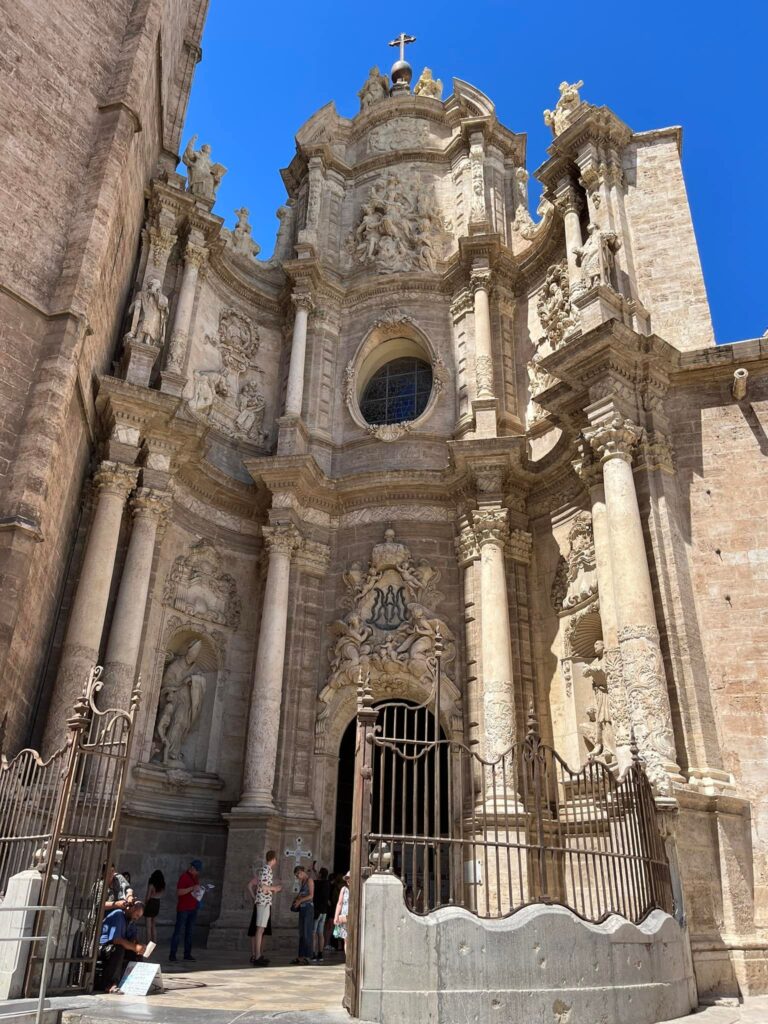
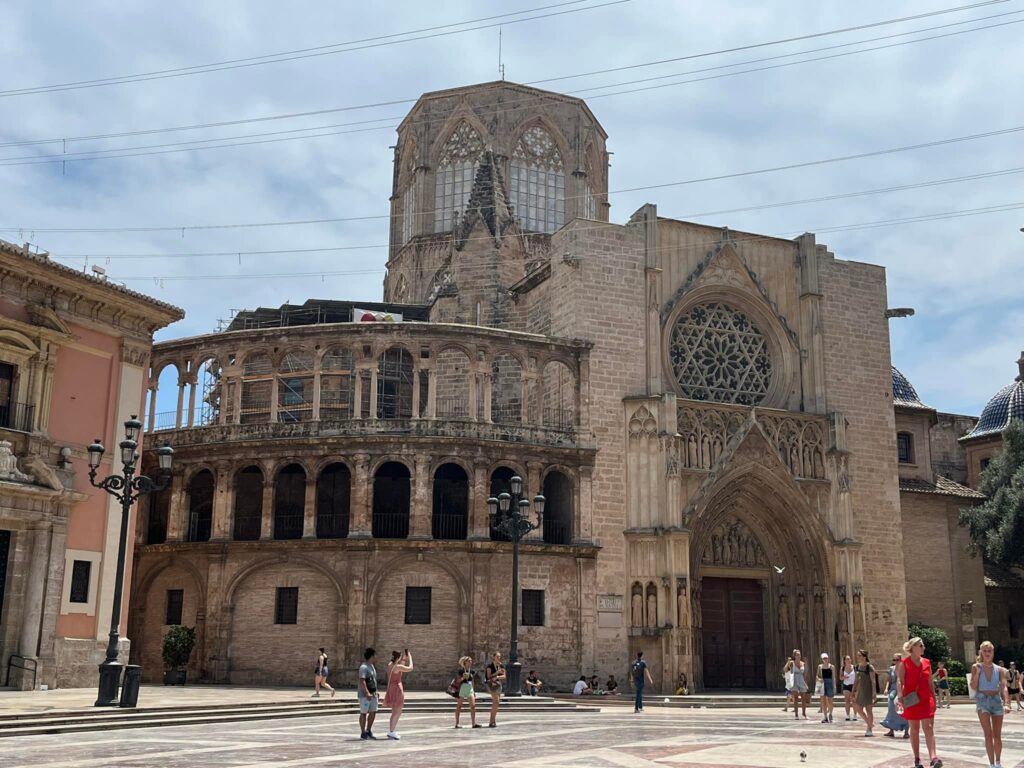
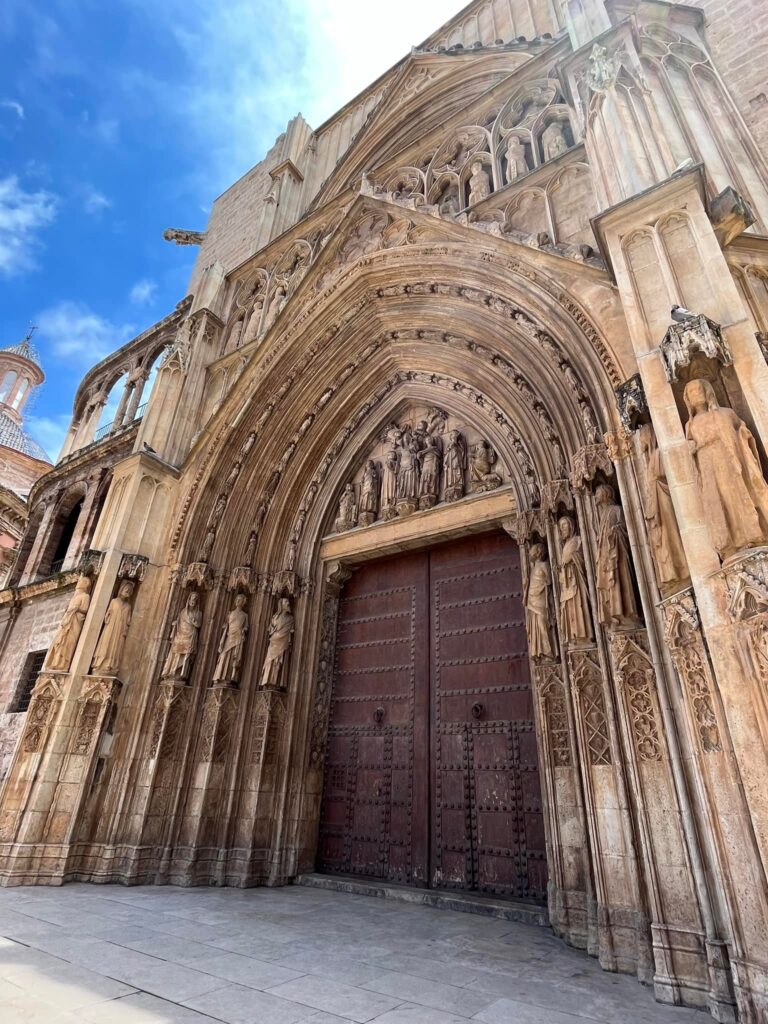
The doors of Almoina. I’m not sure that is spelled correctly. Preserved from the time of the Moors, the original site beyond the doors created a crossing point to the city of Mecca (pre-Cathedral).
The sheer size and design of the alter is awe-inspiring and is truly the heart of the Cathedral. The alter piece doors are tempora and oil paintings done in the 16th century and summarize the life of Christ.
There are 4 Evangelists supporting the lantern tower above the alter. Here is St. Luke.
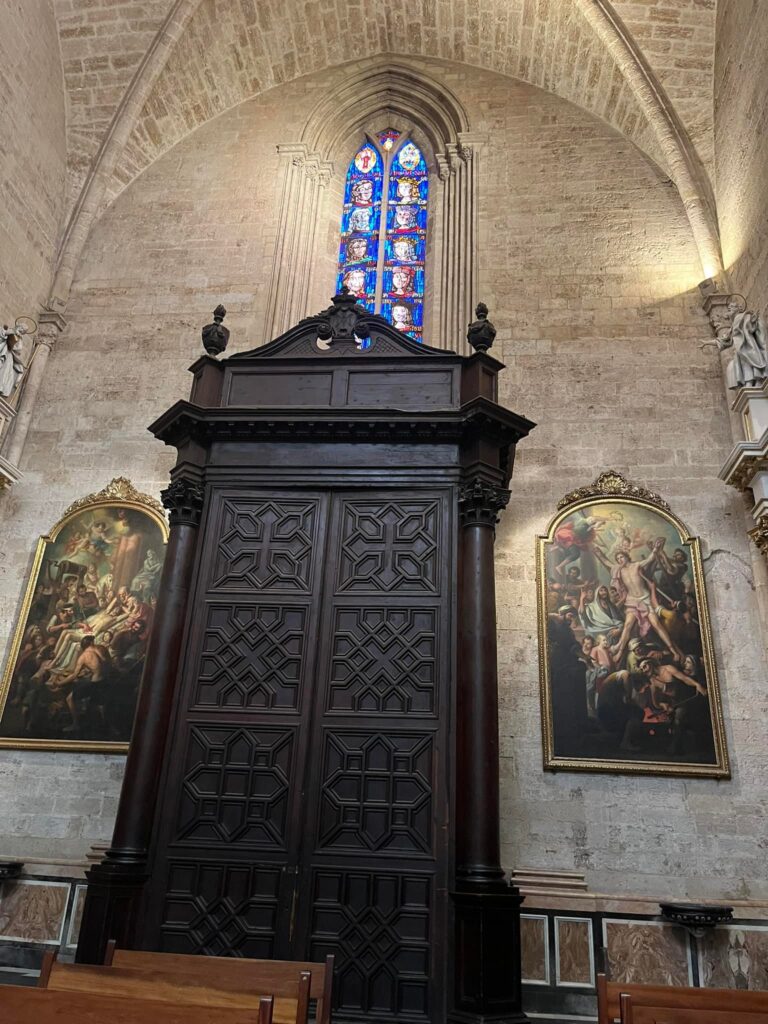
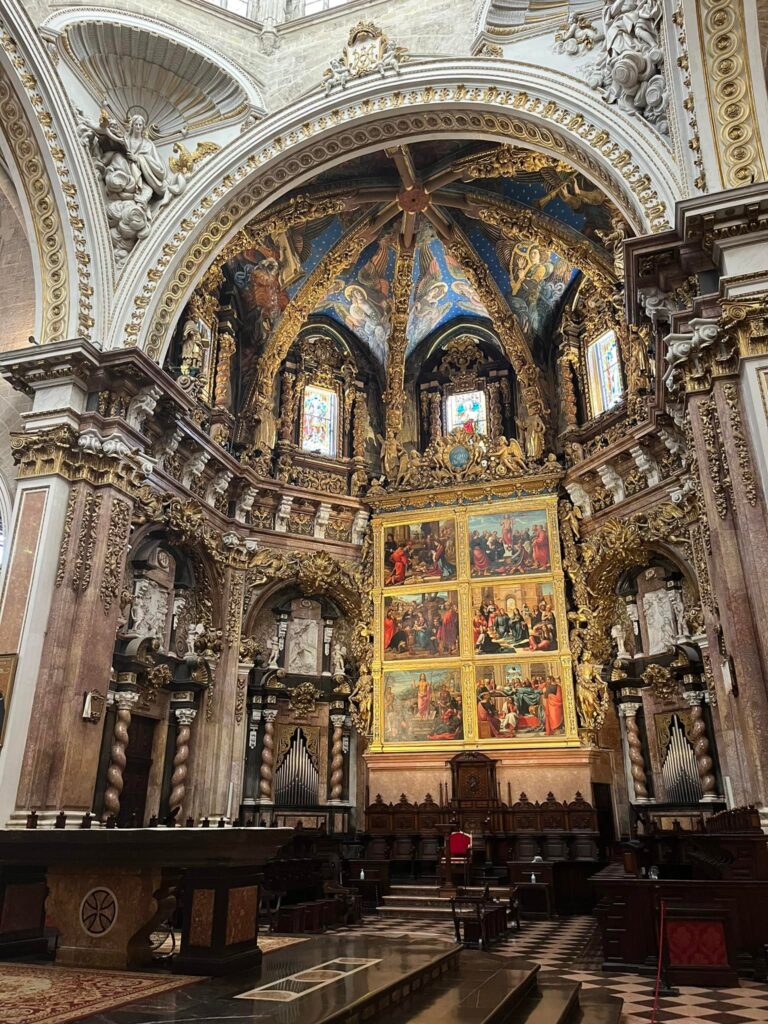
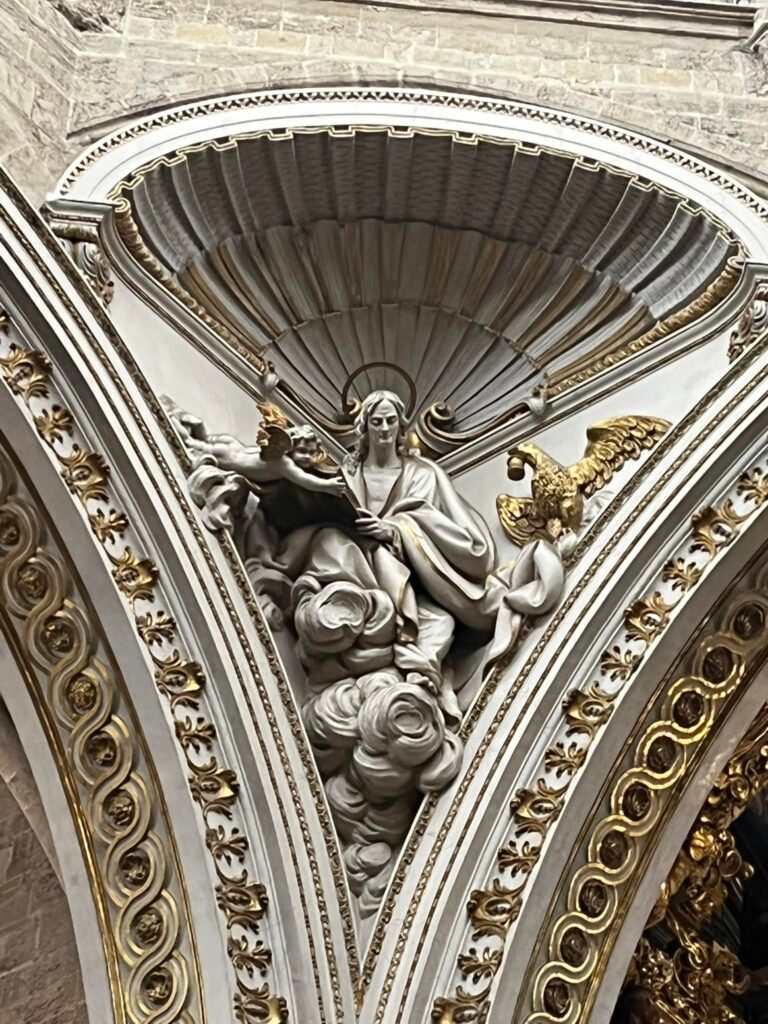
The ambulatory is an enormous circular hall behind the alter. It is romanesque in structure to allow for the mass flow of increased believers visiting various relics (some of them human bones!) in the 8 small chapels that are included.
One example is the Chapel of the Resurrection, also known as the ”Little Cave”. Yes that is an arm. The intact arm of the patron saint of Valencia, Saint Vincent of Saragossa. Considered the most important relic of Valencia!
In the ambulatory you will also come across the Seated Virgin of the Chair sitting on a gold decorated wooden thrown from the mid-15th century. She is a big draw due to a tradition initiated by pregnant believers in the 19th century. If they are about to give birth, the come to pray to pray to her, offer flowers, and walk around the Cathedral three times to ensure a joyful birth. Relatives light votive candles when the baby is delivered.
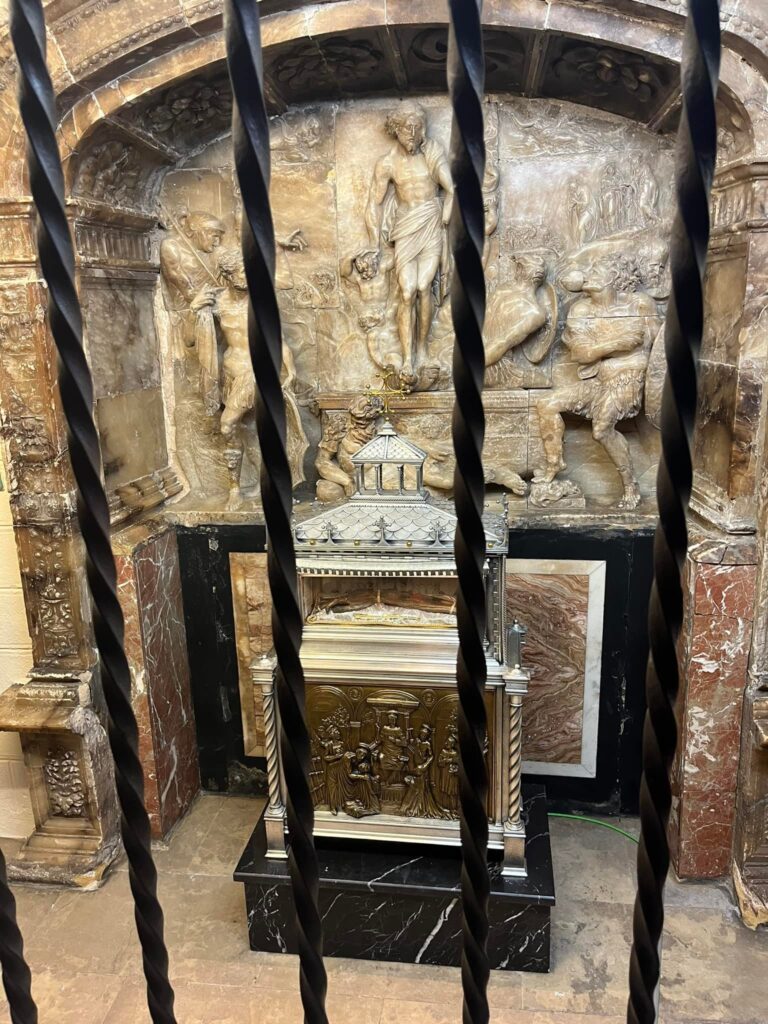
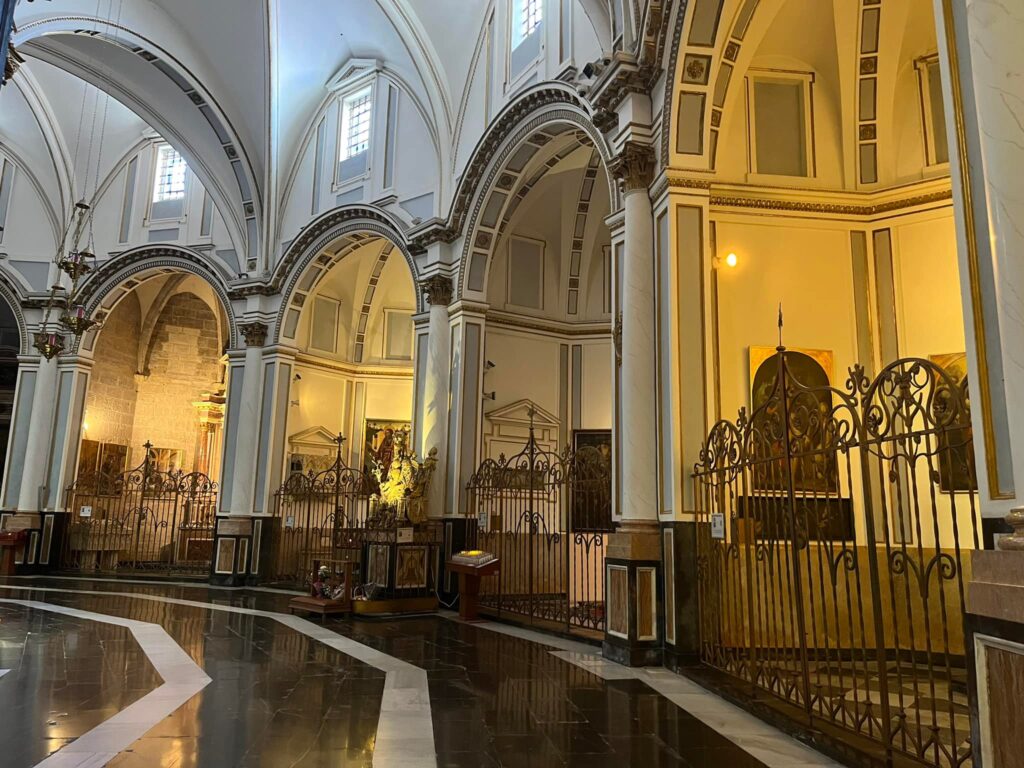
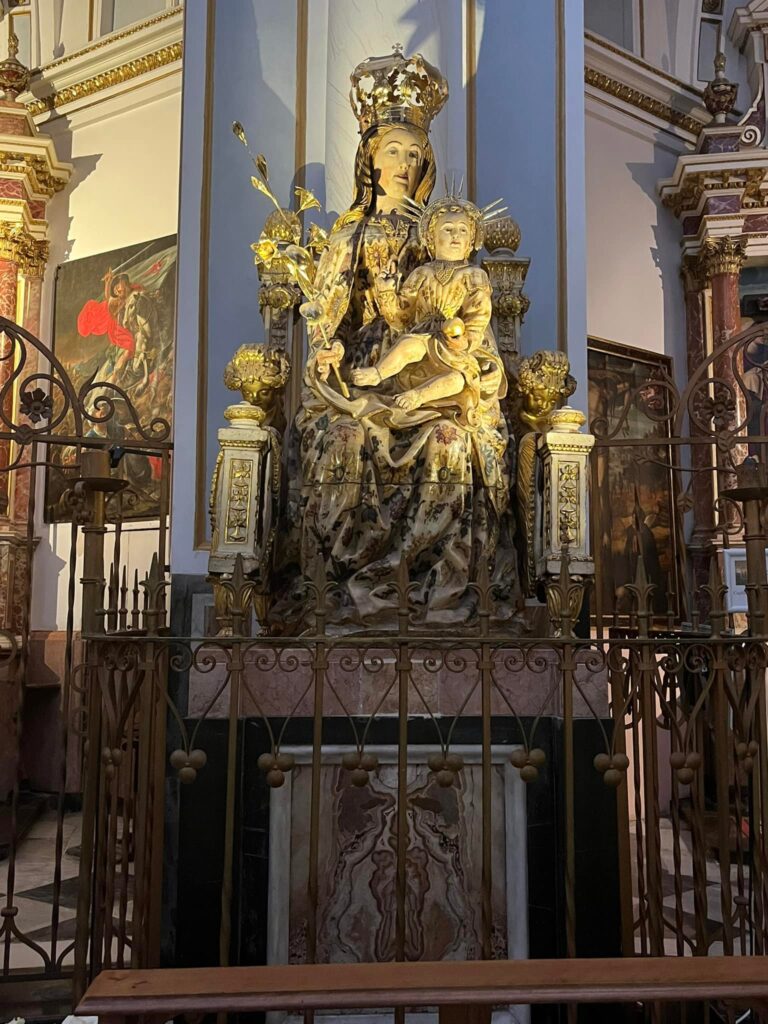
There is a Museum within the Cathedral that highlights Valencian Art, architectural, and archeological items in and around the church from the 1st to the 20th centuries. One of the highlights was the monumental gold plated silver monstrance with precious stones used in the procession of Corpus Christi. Considered the biggest monstrance in the world. It was a votive offering of reparations for sacrileges made during the Spanish Civil war in the 1930s. 600 kilos silver, 5 kilos of gold and 750 grams of platinum were used in its construction. It is a sight to behold!
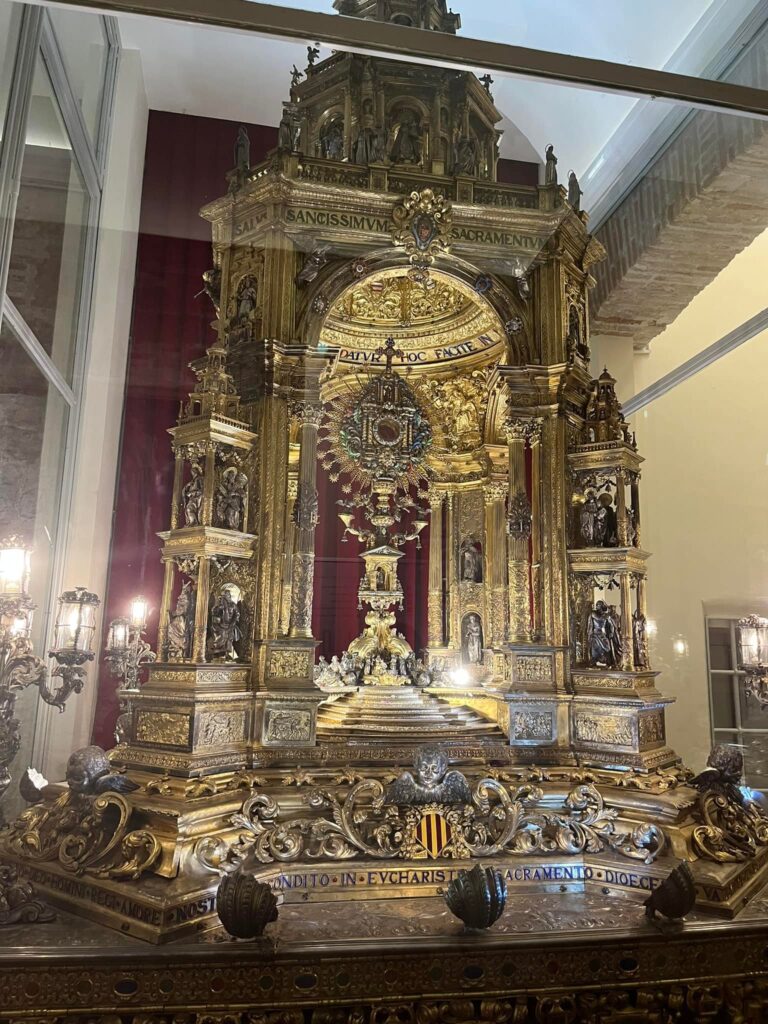
You can then descend below the chapel down another 3 meters. Below you can view an area that was essentially an 8th century water tank that has four different rooms revealing the remains of different periods history still to this day to include a 1st century sewer system of a pre-roman street to visigothic arabic remains and medieval ruins. Also, human remains from a 15th century cemetery littered throughout the walls. Definitely haunted…
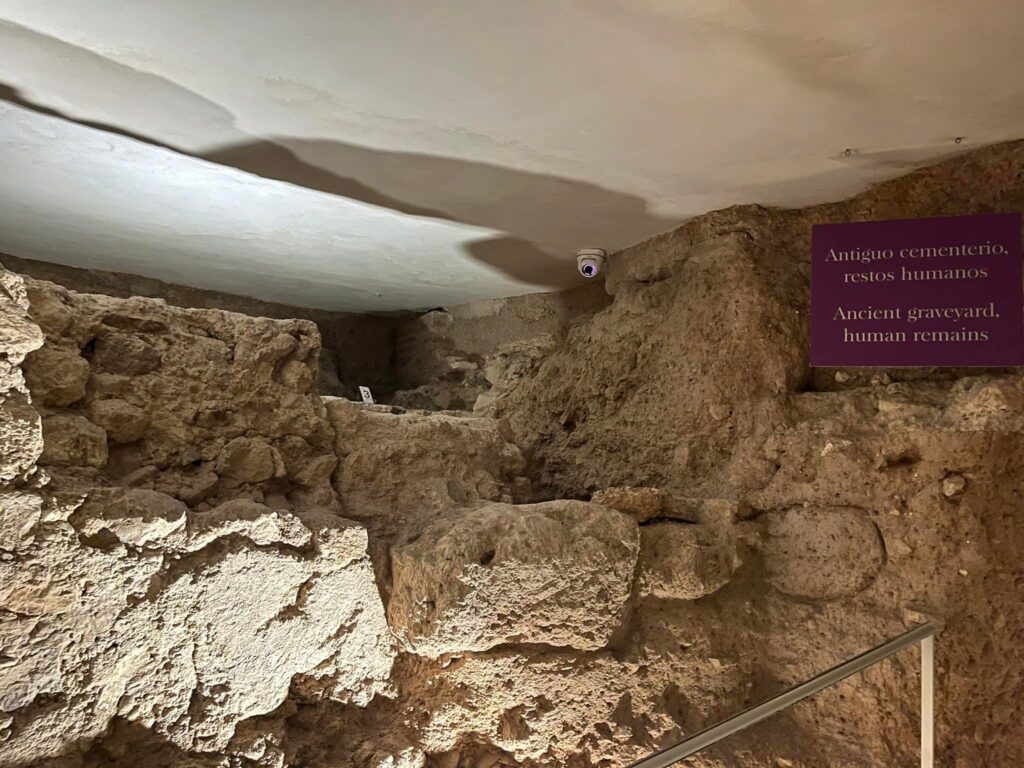
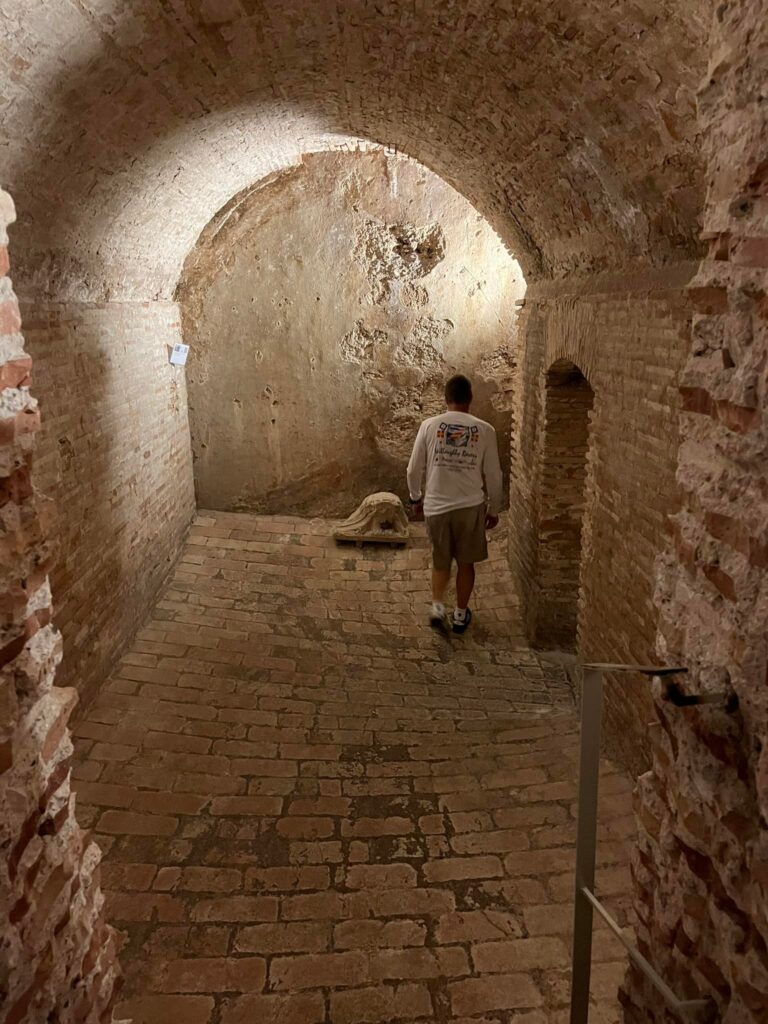
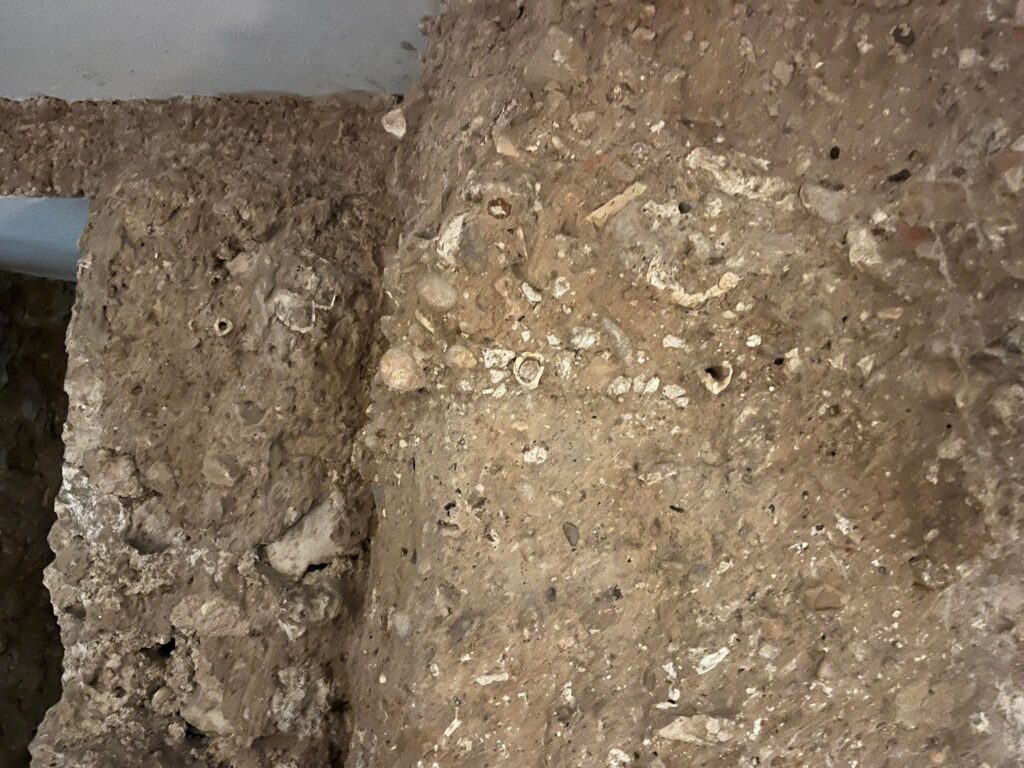
And the true highlight, The Santo Caliz Chapel, a 14th century building off the main Cathedral. Here is where you find the Holy Chalice that, according to historical convention, was used by Christ during the Last Supper. There was a surprising lack of visible security for such an amazing artifact. The backdrop alter is made fully of carved alabaster. Gregorian masses take place here daily. I wish I had known. I would have totally scheduled our visit for that. The acoustics in there must be incredible!
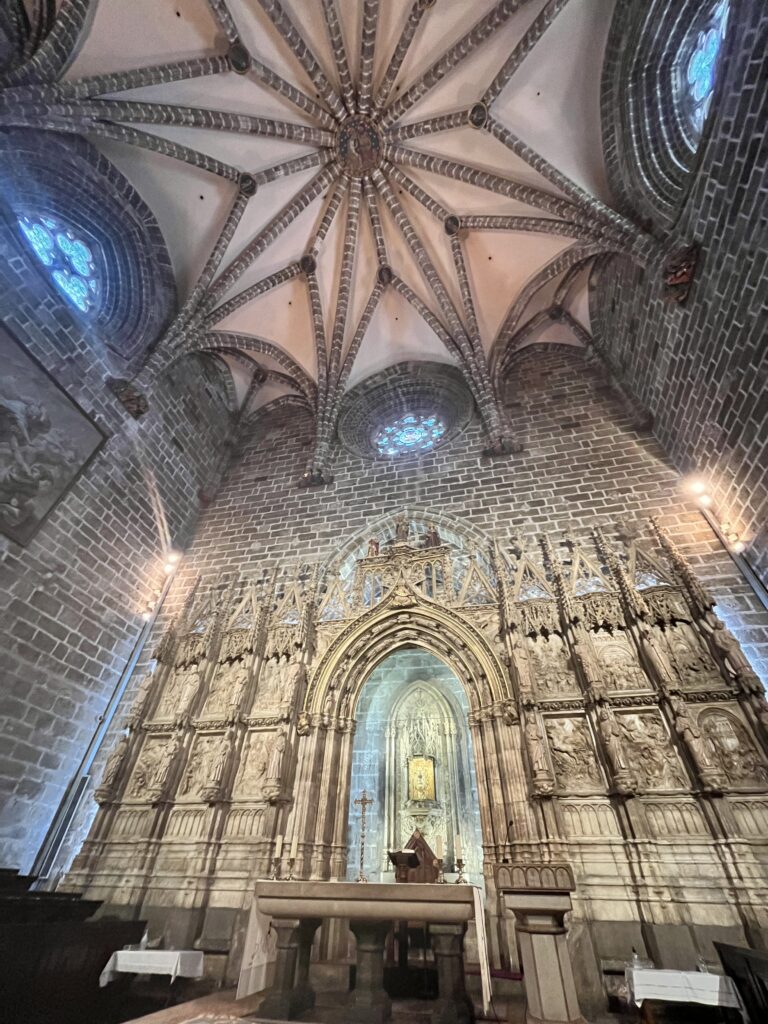
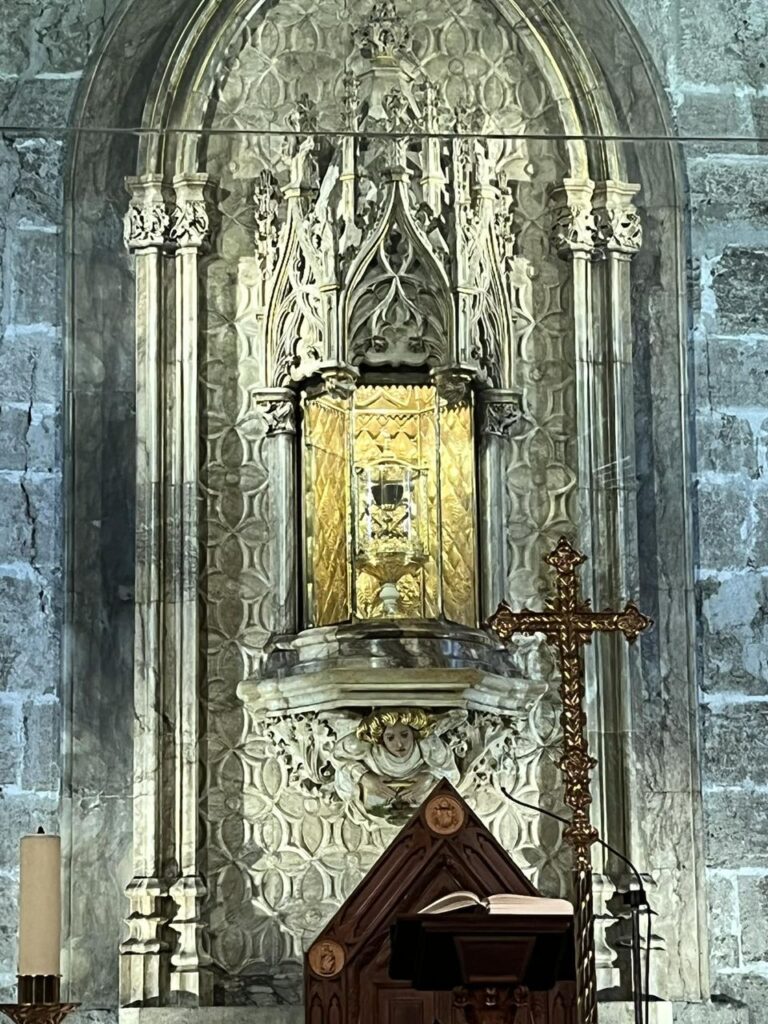
More on the cup for those interested. The main cup is the Alexandrian cup from the 1st century BC made from polished stone (the dark cup in the center). Decorative elements were added later over time. It arrived here here in the mid 15th century after a long history. Decide for yourself! Here is a good write up about it:
https://www.bbc.com/travel/article/20220414-does-spain-have-the-holy-grail
Personally, all we could think of looking at it was this:

CF Valencia Fútbol Game
Our first attempt to cross off a life-long bucket list item of ours, to see a Fútbol game in Europe, failed! We had purchased tickets for the last CF Valencia home game of the season. Got jerseys. Showed up. Apparently that night’s scheduled game was actually played the night prior for TV purposes…they just changed the game for better coverage and the only way to know that without a TV was via their website?! Apparently all the English speaking fans missed the memo. We were all outside the stadium wondering where all the crazy pre-game party we had expected was!
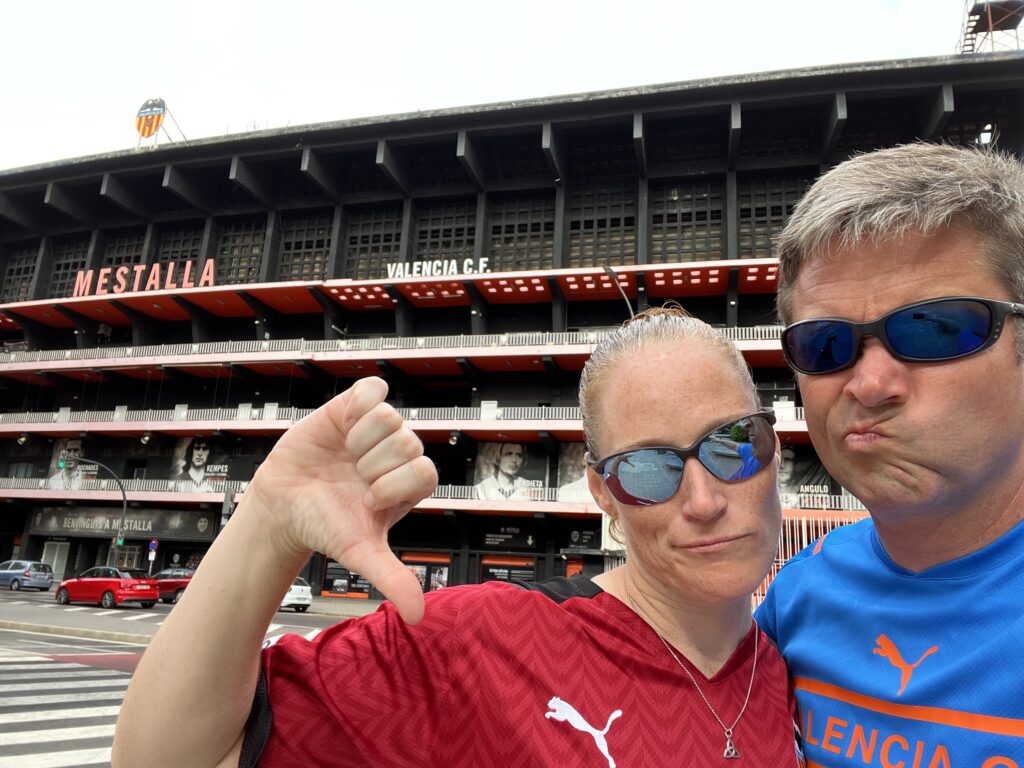
In September, the beginning of the next season, we managed to get tickets again and made sure we followed their schedule closely. It was quite wild. All the alcohol was consumed before the game, outside the Mestalla stadium. (no, really, we’re pretty sure the pre-game fans tried to consume ALL the alcohol in Valencia) Hell of a party with cans and bottles strewn about EVERYWHERE. You had to enter the stadium via the section you were sitting and you were stuck in that sliver of stadium until the game was over and no alcohol is served in the stadium. These two setups apparently keep fans from brawling with other fans during the game should it get “exciting”. It was everything we hoped it would be, loud and exciting! They ended up winning 3-0 against Celta Vigo.
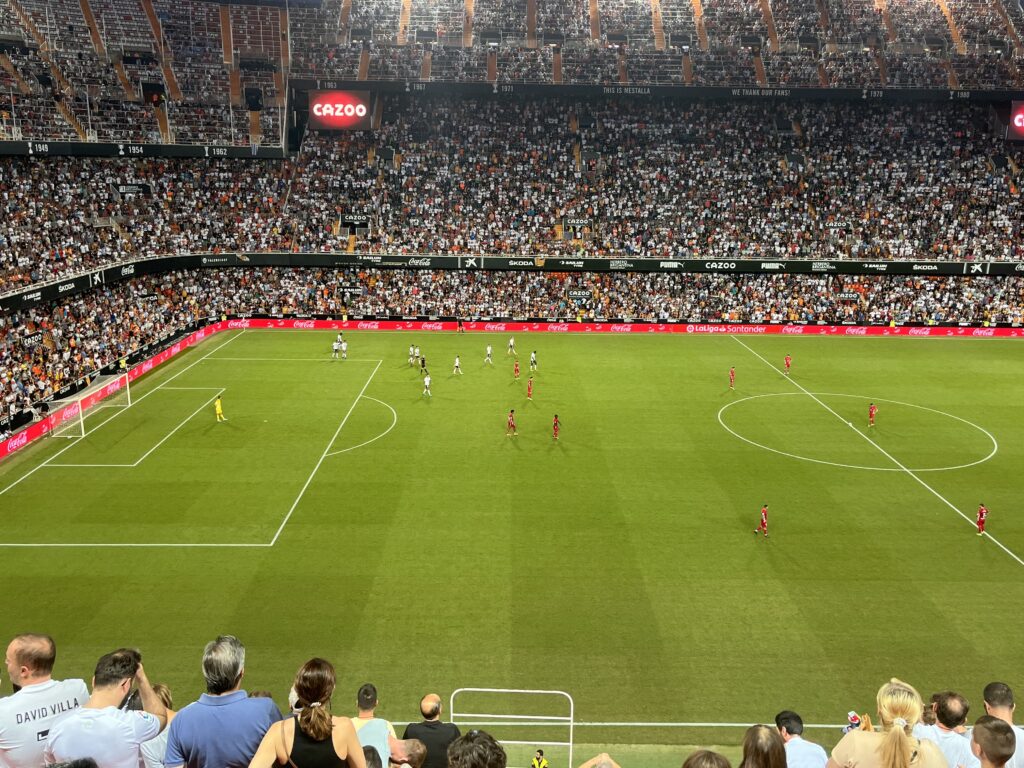
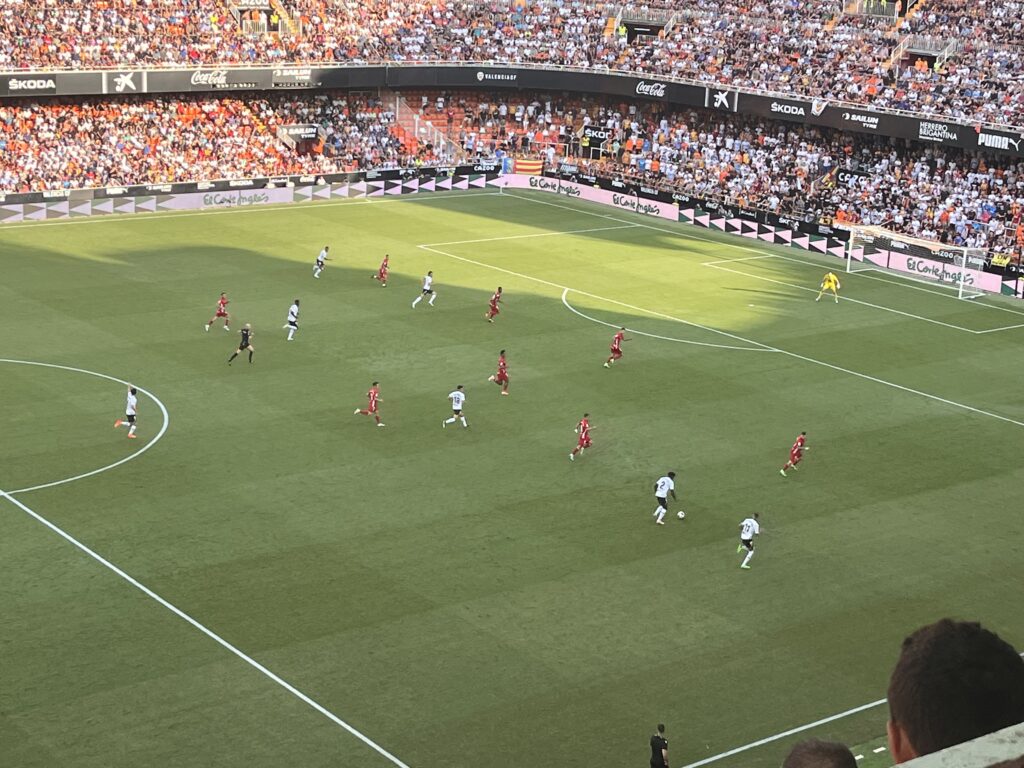
The Amazing Architecture
We quite literally biked all around the city and everywhere we looked was history and beauty. Due to the incredibly lengthy history of the city, there is a mash up of styles sometimes all mixed together such as gothic, Neo-classical, baroque to name a few. And let’s talking about biking accessibility. Pedestrians rule here. There are bike path arteries all in and around the city. We biked from Valencia Mar to the airport to pick up a package. It’s a 20 mile round trip. Not once did we have an issue or feel endanger from motorists. They do not use their phones while driving AT ALL and the paths have the right of way in most side street crossings. Anyway, here are some of our favorite sights we passed often:
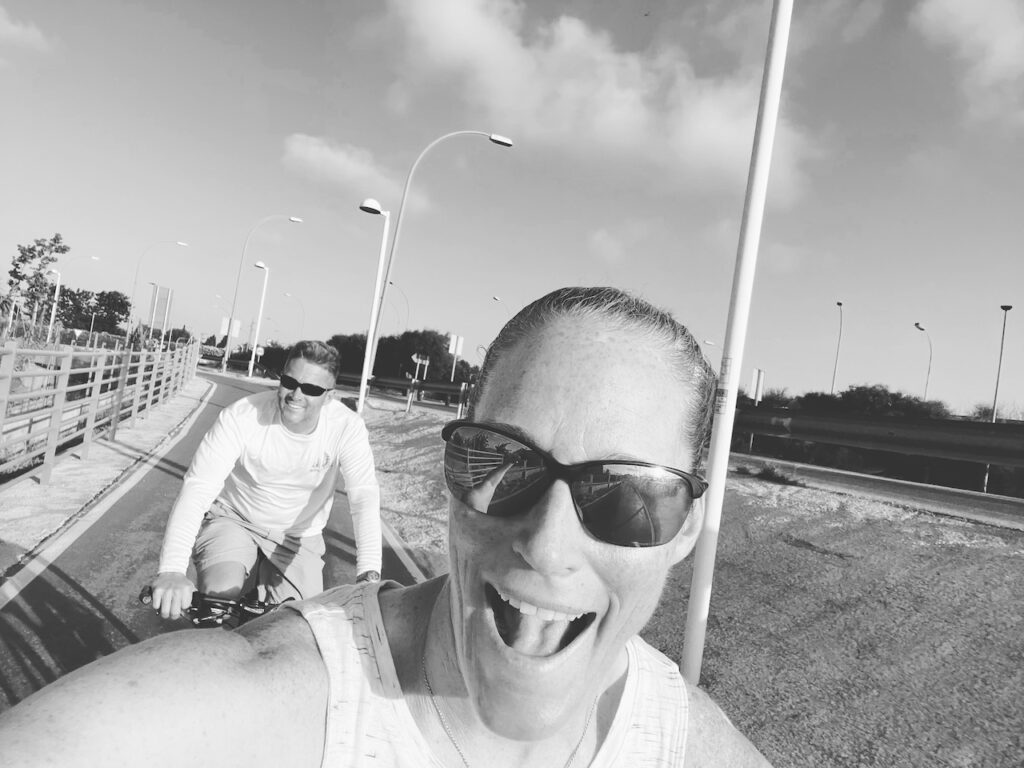
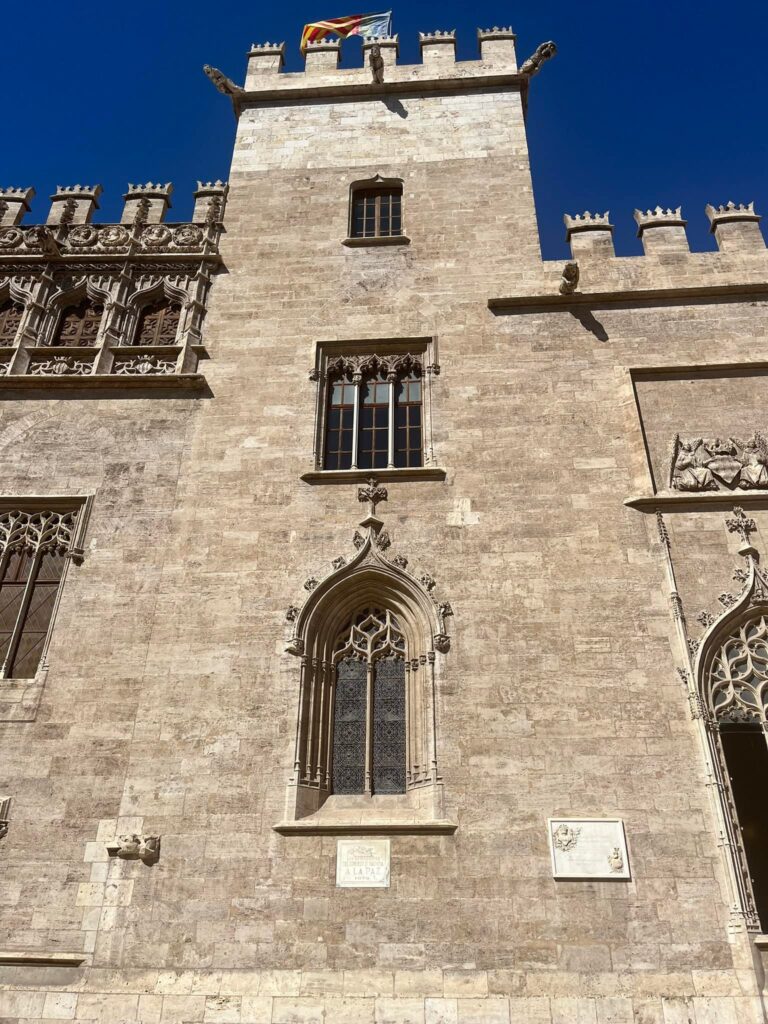
La Lonja de la Seda (Golden Era) Once a gorgeous medieval silk market. It was built during the 15th century golden age as a display of Valencia’s wealth at the time, and now it’s famous as being one of the few examples of non-religious Gothic architecture in Europe. It’s now one of the most important buildings in the city, and a UNESCO World Heritage Site.
Santos Juanes Church in Valencia (Iglesia de San Juan del Mercado o de los Santos Juanes) was declared National Historic Monument in 1947. It was built in Gothic style in 1240 over a mosque. Although it is popularly known as San Juan del Mercado Church, its real name is Royal Parish of Santos Juanes
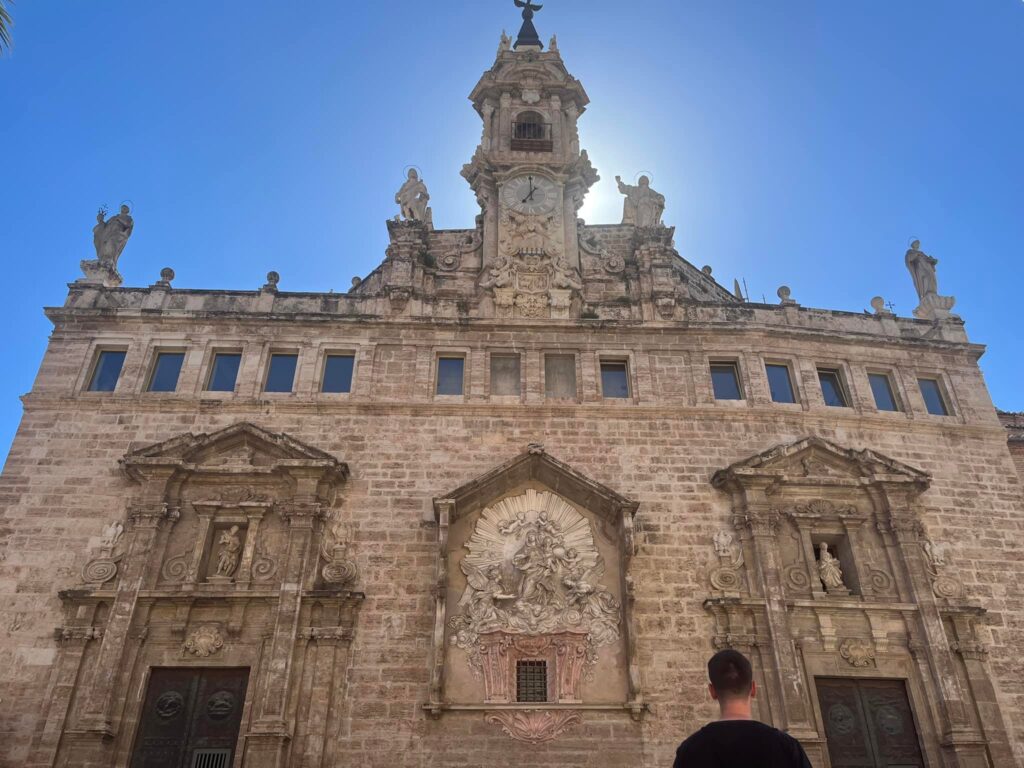
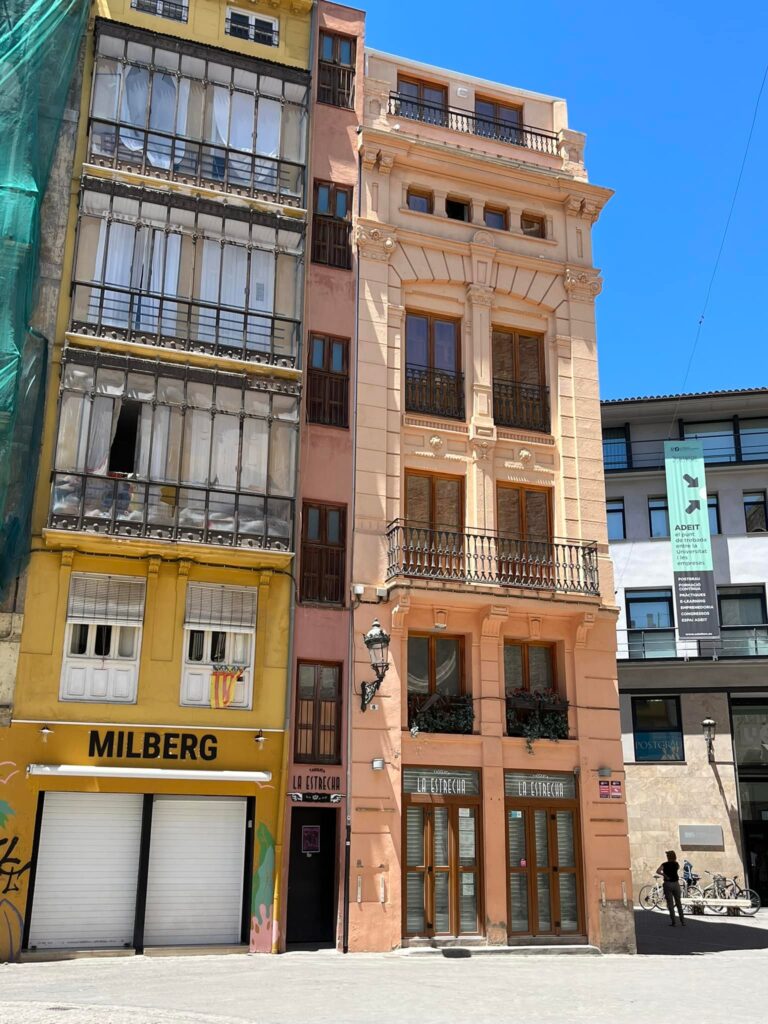
After our tour of the Valencia Cathedral, we stopped for some tapas. While eating we noticed a lot random tourists taking pictures across the plaza. Only then did we notice the pink strip of building at the center of a row of other buildings. We later learned it was the “Narrowest estate” in Valencia. At 107 cm wide it is the 2nd smallest in the world (one in Brazil has it beat my a few cm). Would loved to have seen the inside! In the accompanying photo, it is the thin pink strip in the center
Santa Catalina is a Gothic-style, Roman Catholic church. The church was built in the early 13th century at the site of a prior mosque (sensing a theme here). Most of the interior was rebuilt after a fire in 1548 acquiring the baroque style that is seen today. It has a 16th-century portal of classicist style.
Part of the church is one of the most notice landmarks that is forefront at the heart of the old town quarter in Valencia, the seventeenth century baroque tower of Santa Catalina.
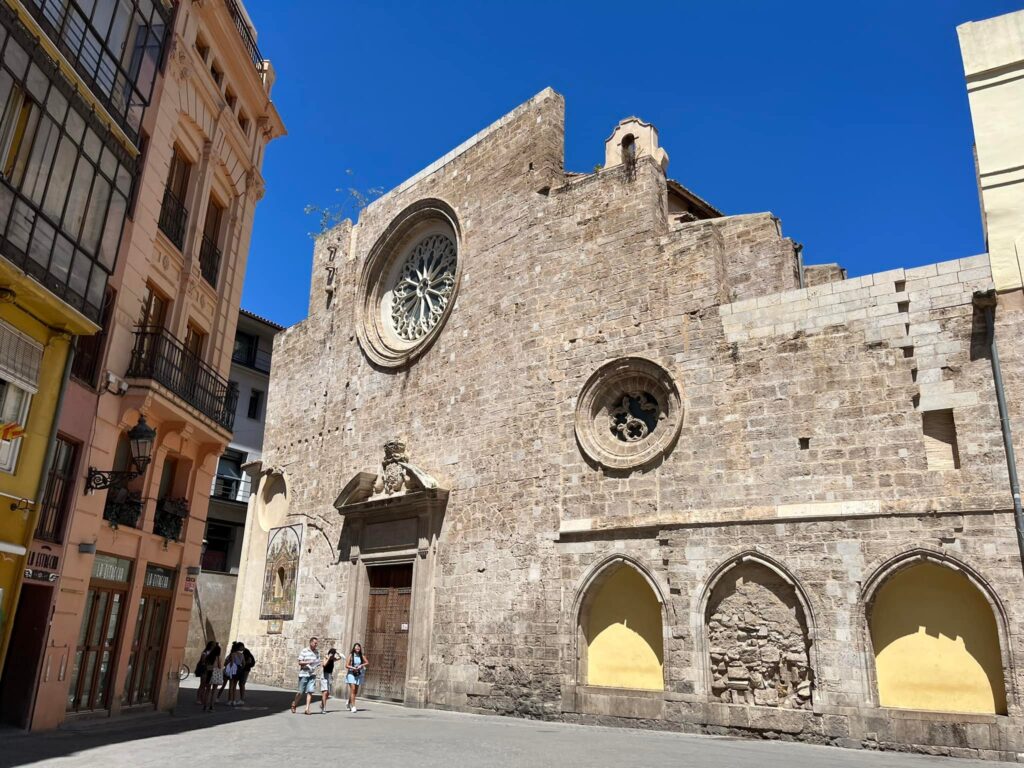
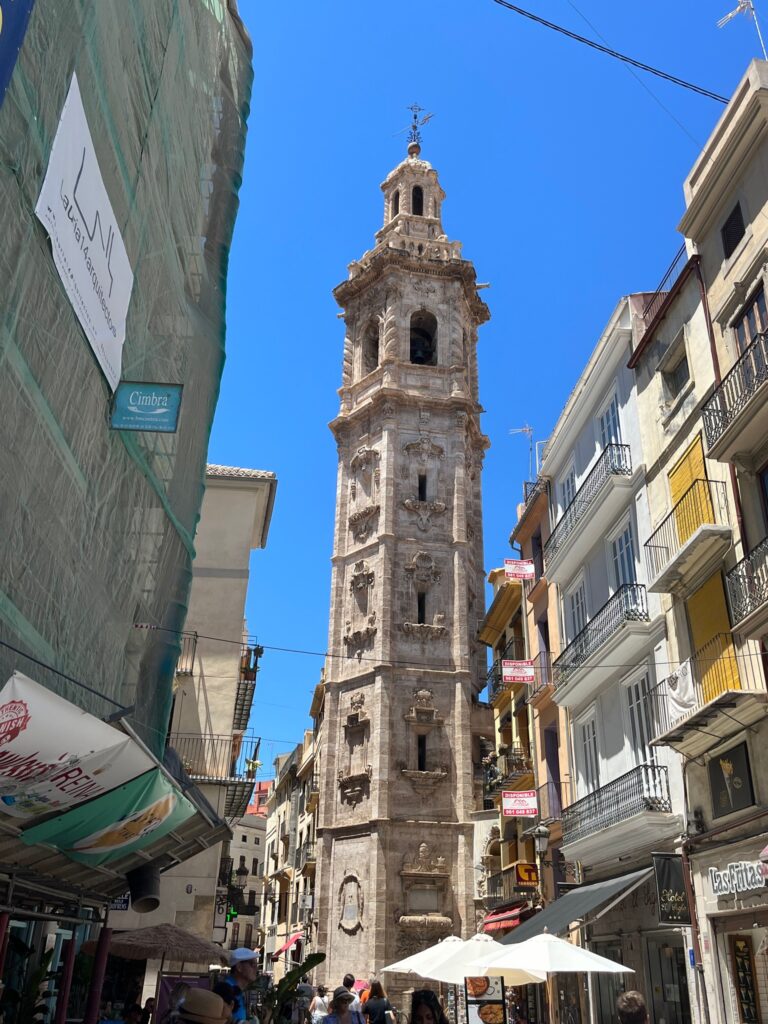
The Palace of the Marques de Dos Aguas (now home of the National Museum of Ceramics). It was originally built in the 1400s as a Palace by the Rabassa de Perellós family following the marriage of Francesc de Perellós and Joana Rabassa. It has a long history including a few fires and renovations (A theme with many buildings here).
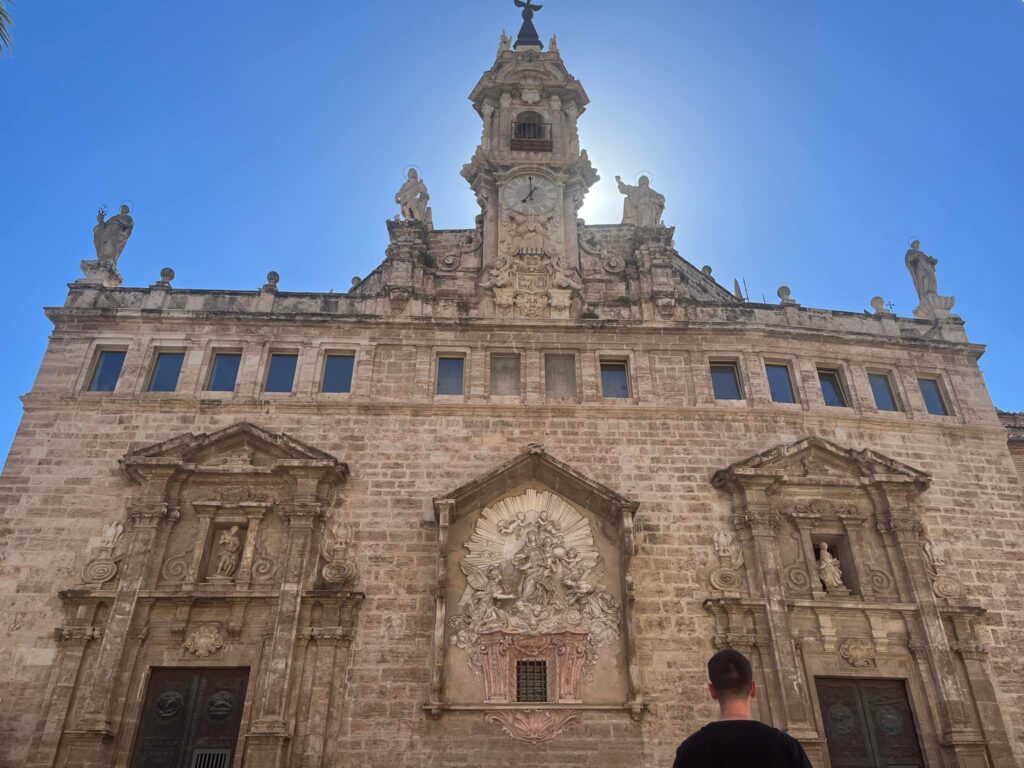
Plaza de Toros de Valencia. We passed this structure often on our travels through the city. It is an enduring symbol of Spanish history and culture. Built y Charles the IV in 1796 over a previous one from 1760, it is touted as one of teh most beautiful and ancient bullfighting coliseums in Spain. We had no idea it was actually still hosting bullfighting events.
Ok, so, this event is quite controversial in its existence. We were hesitant in going for that reason or even featuring in our blog and social media that we went. We are big on experience the cultures of the places we visit so we felt like we should at least check it out. And while we will not show the events beyond the pageantry involved, and the pageantry was AMAZING, we will spare you the rest. So, we’ll say this…We saw Spanish bull “fighting.” Aaaand we left before it was over. While an interesting view into another country’s heritage, it went against everything we were taught about killing an animal…for food. Yes, they do eat the bulls at the end of the show and use all parts of it for various things. However, we disagree that this should be done as sport in the form presented. They could have done more to end it “quickly” or just left it at the pageantry and let the bull move on. Those are our thoughts. We give it 1 star. I imagine it is only a matter of time until this practice no longer exists. Of note, you can visit the stadium and go to the museum outside of events.
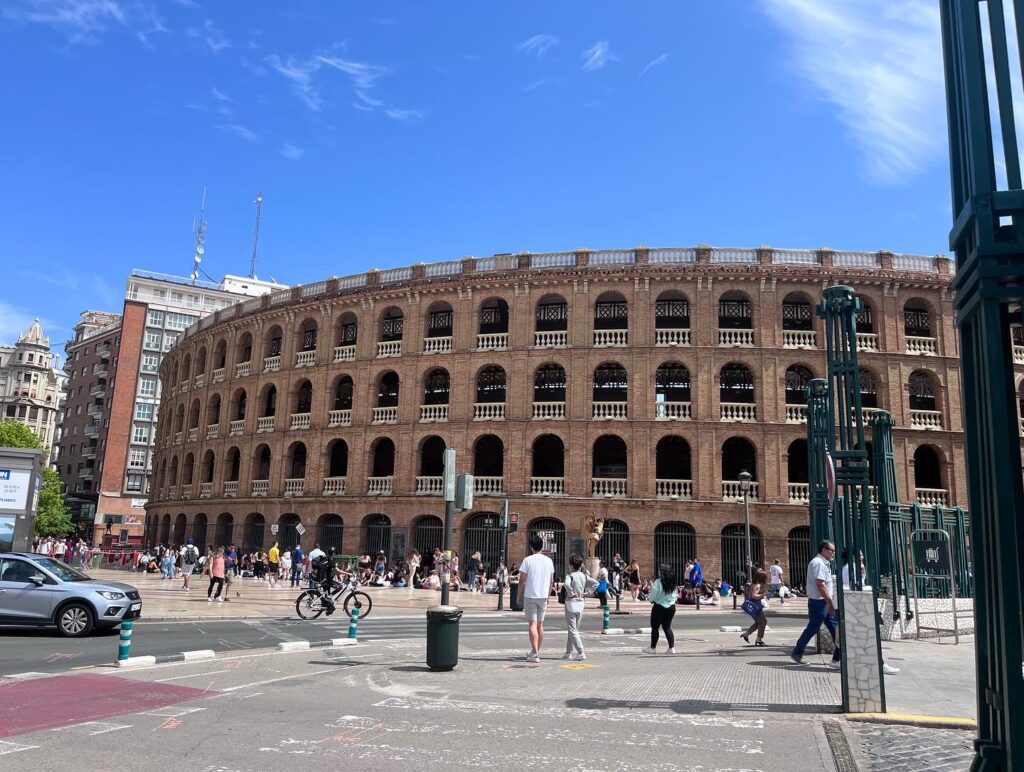
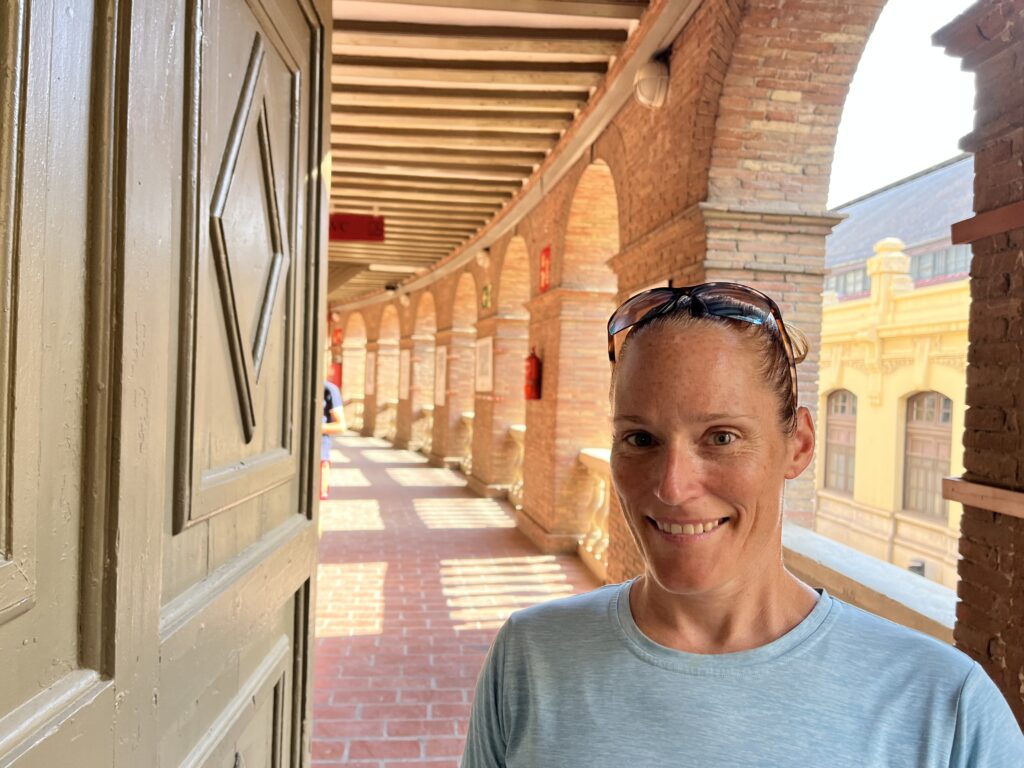
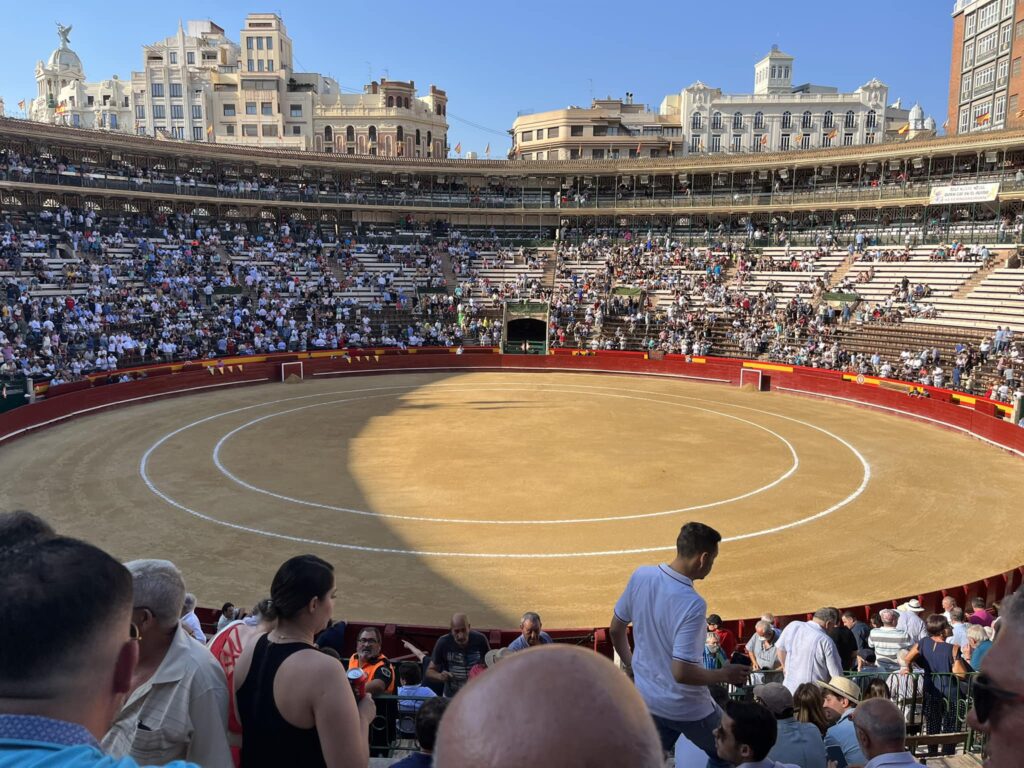
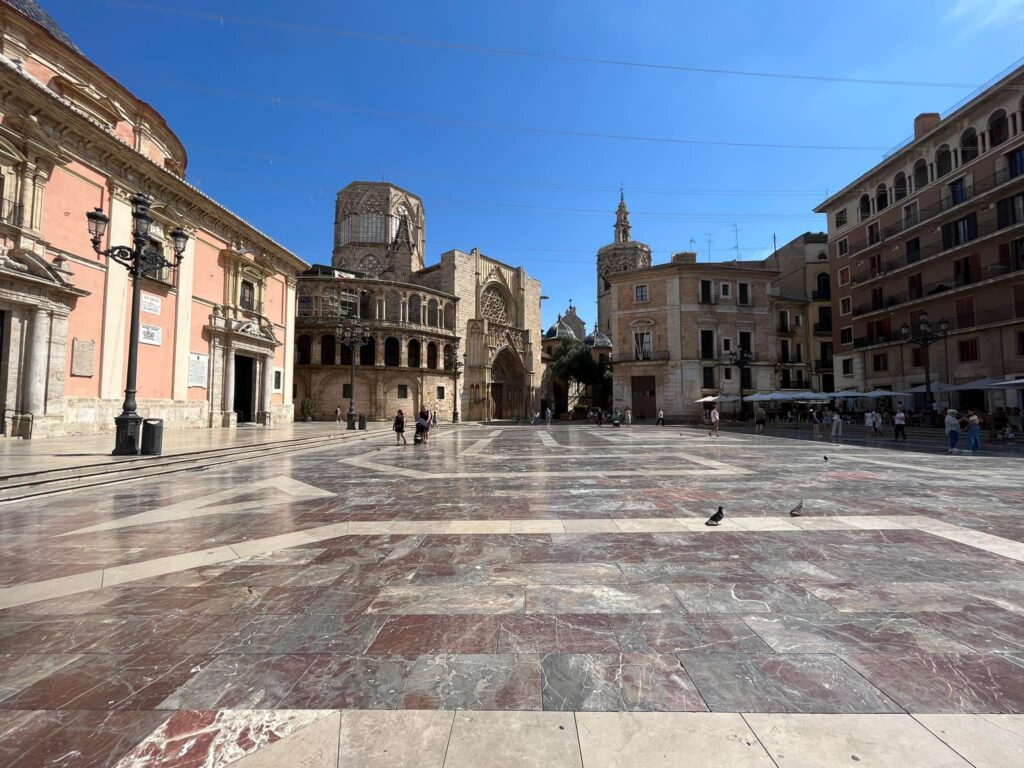
Outside of the Valencia chapel sits the Plaza de la Virgin. One of the oldest squares in Spain. Here lies a fun fountain depicting Neptune surrounded by 8 naked women (virgins?) which symbolizes the ancient irrigation system of the River Turia and its eight water channels.
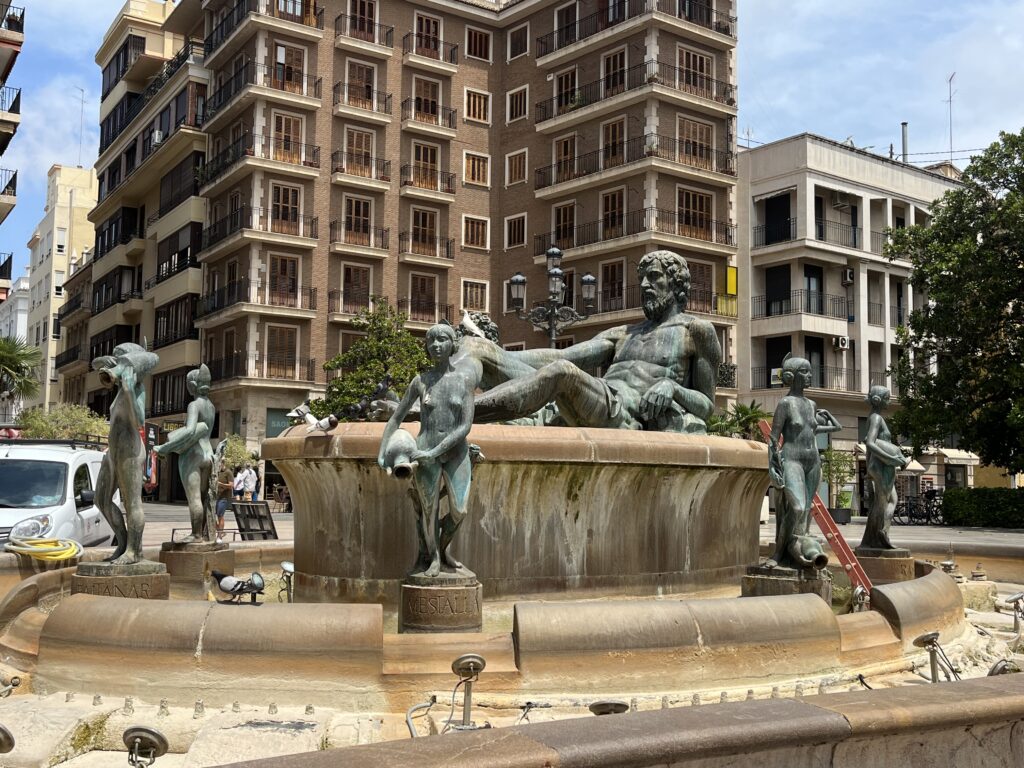
Another random stop we made to have a beverage (we stopped for many cold beverages throughout our travels around the city) during a summer break, was at the foot of the Torres de Quart (Golden Era). This imposing gothic structure with two 34 meter high cylindrical plants, was one of the twelve gates through the medieval city walls of Valencia (the walls coming down in the 19th century). The gate itself was finished in the 1300s, it was originally used to defend the city, notably playing a vital part in stopping Napoleon’s troops in 1808 during the tar of Independence against the French. It later served as a women’s prison. It is an important landmark and is now one of the best preserved monuments of Valencia.
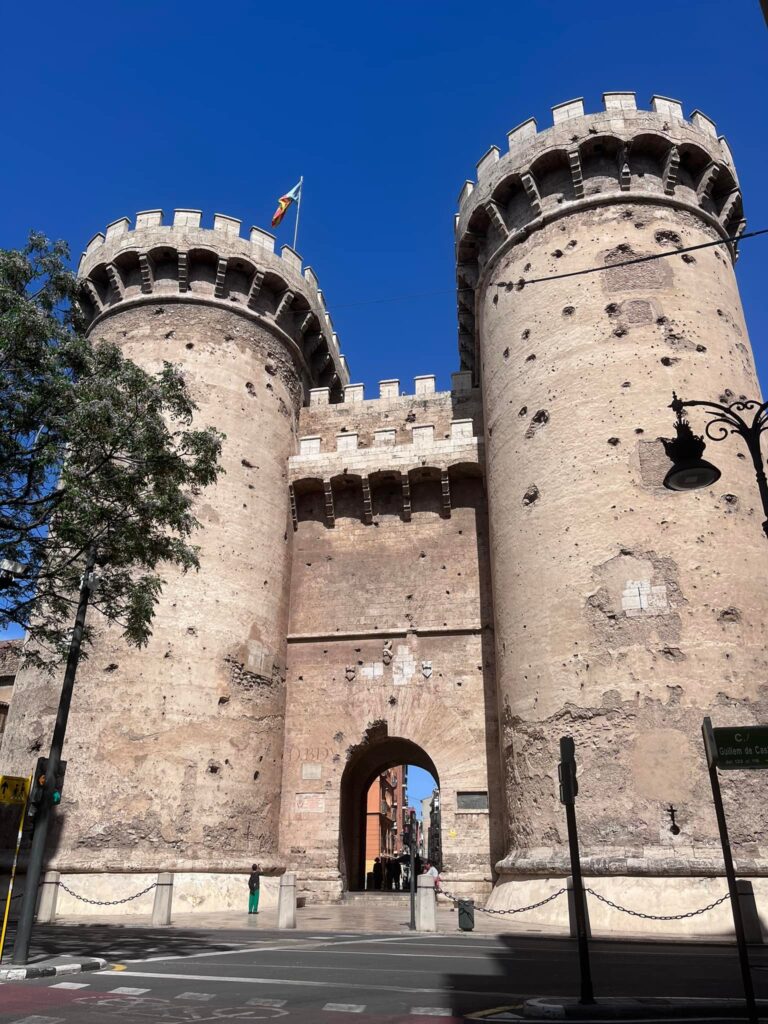
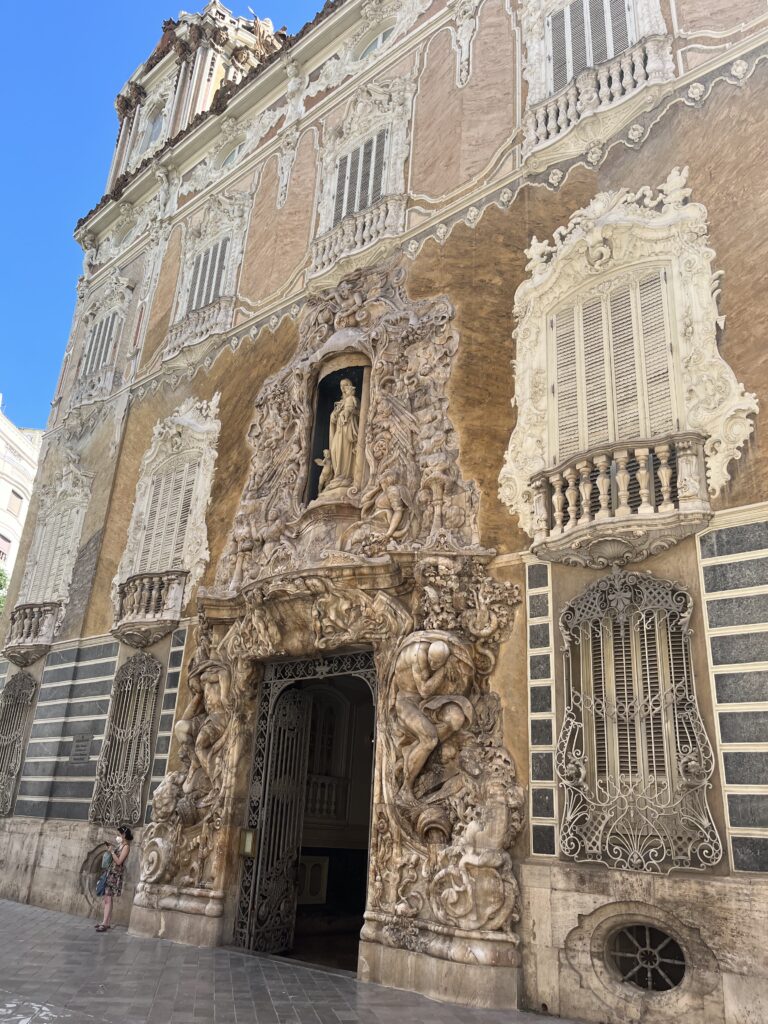
The National Ceramics Museum, located in the heart of Valencia’s shopping district, was completed in 1954. It was originally a stately home, the Marquis de Dos Aguas Palace, that was constructed in 1740.
The Town Hall. While construction began in 1958, the building was not completed until the early 20th century and features. a range of architectural styles including Neoclassical, Neo-Baroque and Neo-Renaissance.
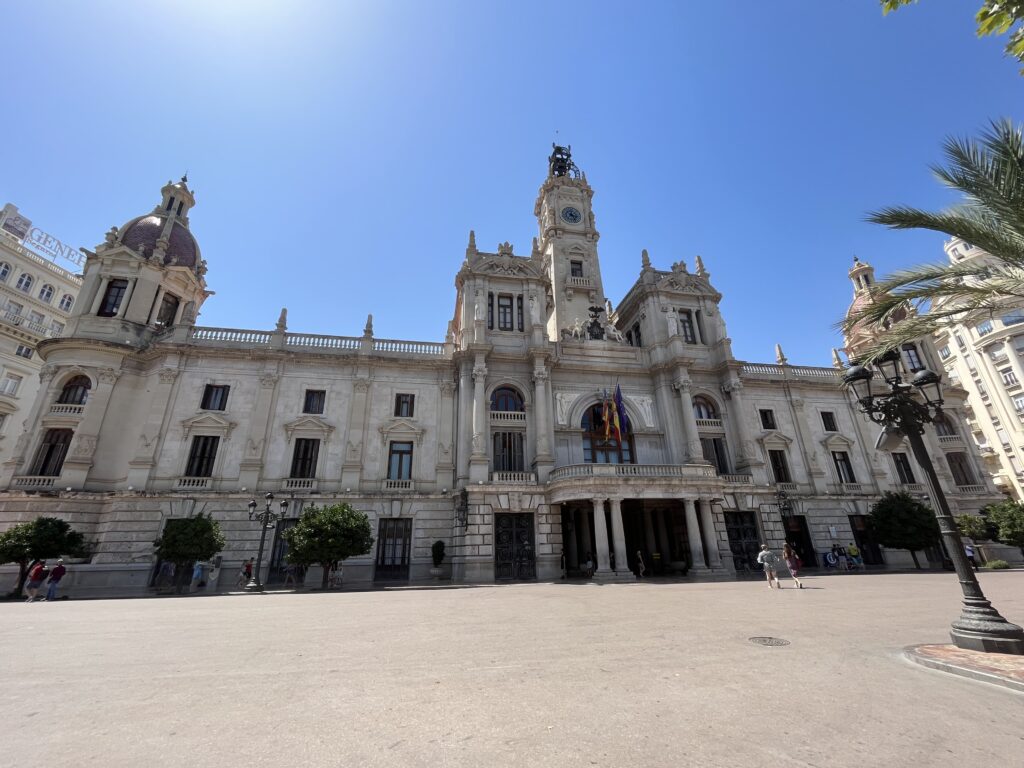
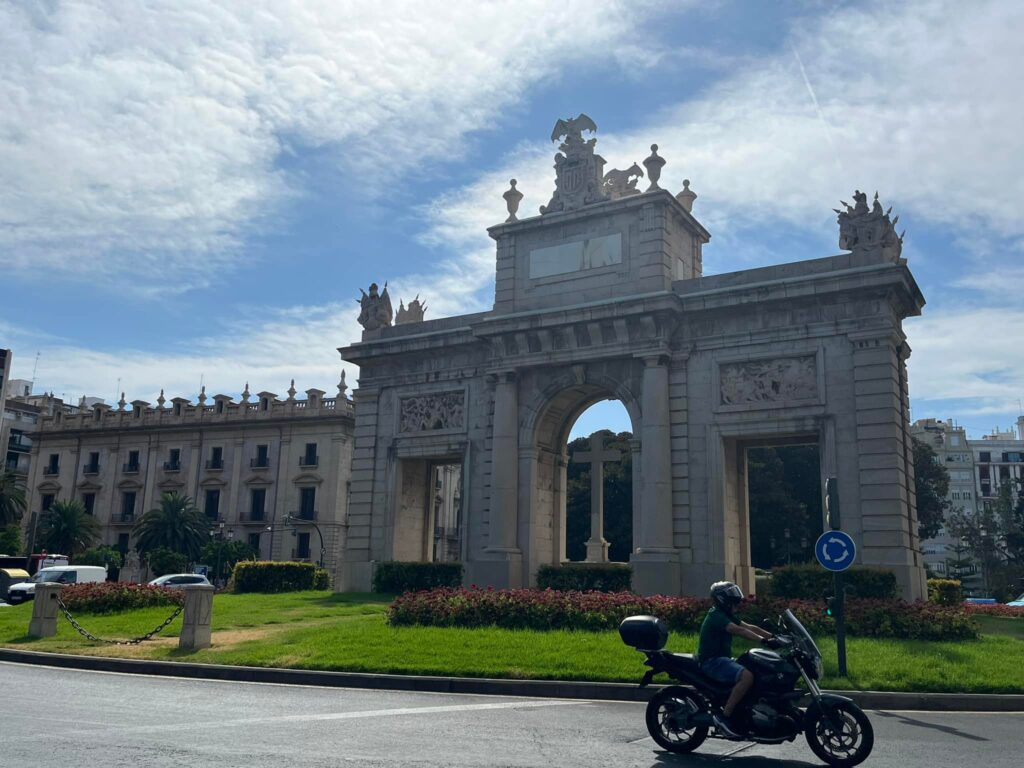
The monument now called Porta de la Mar, the Monument to the Fallen, was built in 1946 in memory of the Fallen for God and the Country during the Spanish Civil War. It was built on the site where the old Puerta del Mar, the walls of Valencia were originally located and is a replica of another of Valencia’s former gates, the Del Real.
In the bustling city center you can find some more mondernist buildings such as the Estaction del Norte Train station, Mercado Central and the Mercado de Colon.
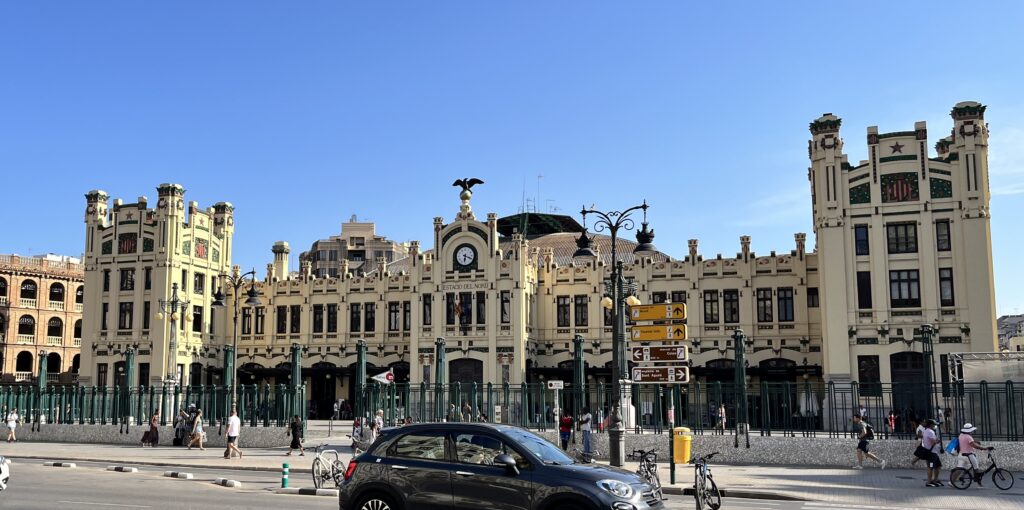
The Mercado Central or Central Market of Valencia. The largest of the markets in the city. Not only is this a sight to be hold as you move through the city, it is affectionately known as the “Cathedral to the Senses”. it is the largest market with fresh produce in Europe with 1200 stalls covering over 8000 sq meters highlighting rich and varied cuisine. It is located in one of the most emblematic modernist buildings in the city. By the way, the fruit is amazeballs.
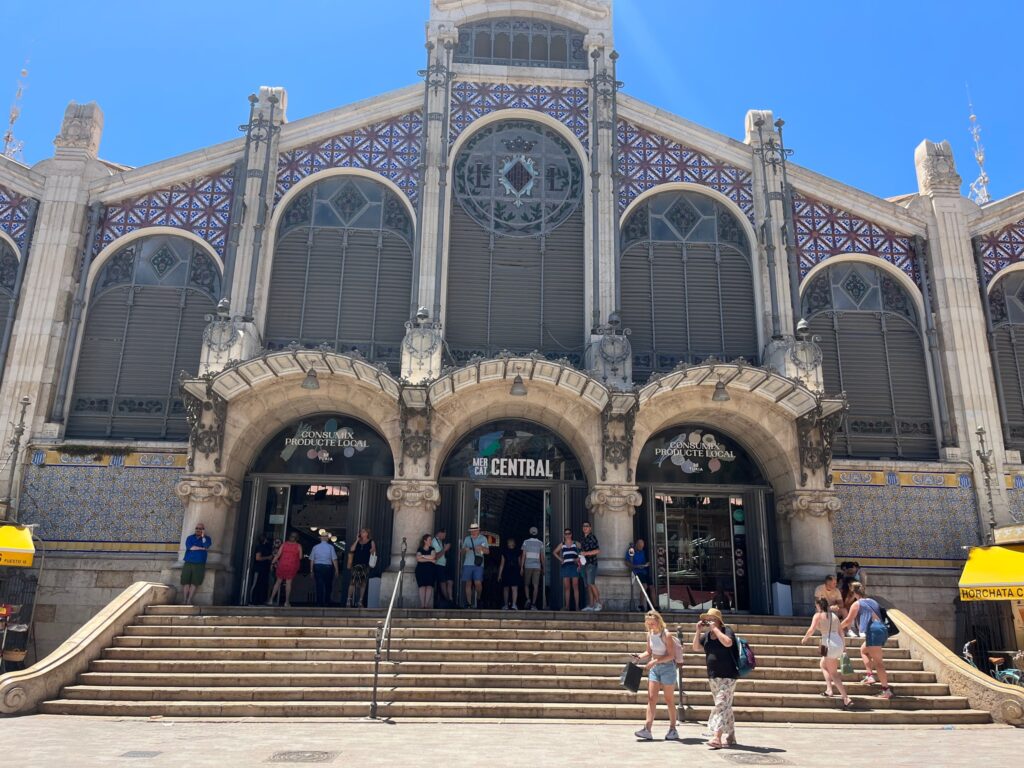
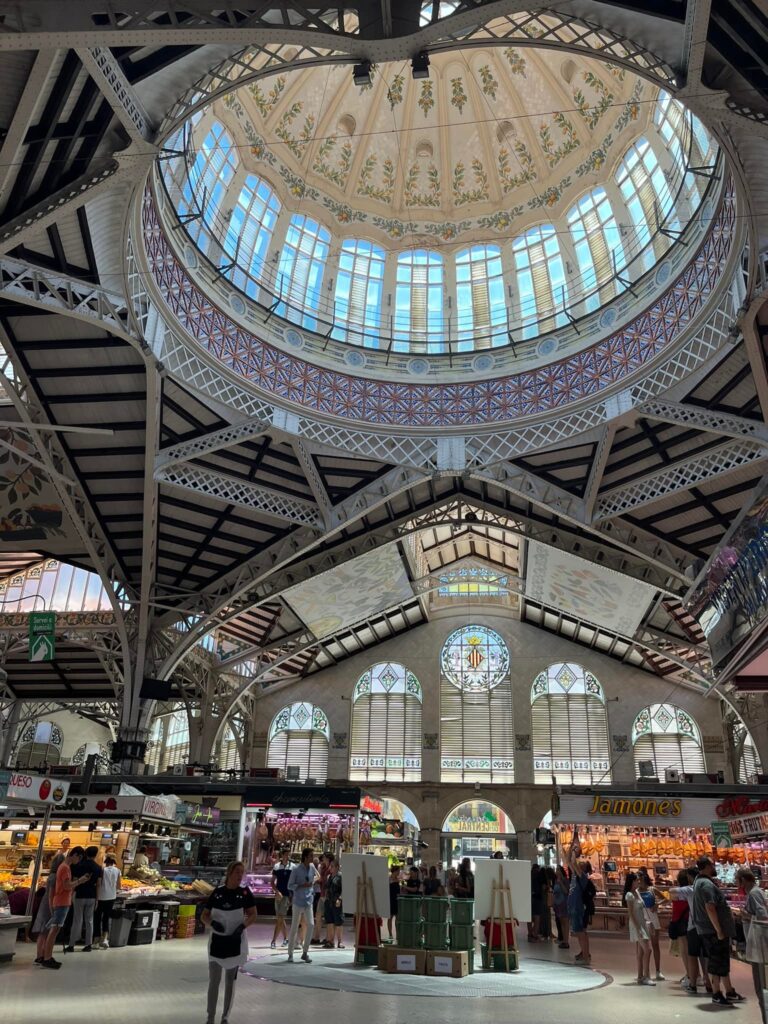
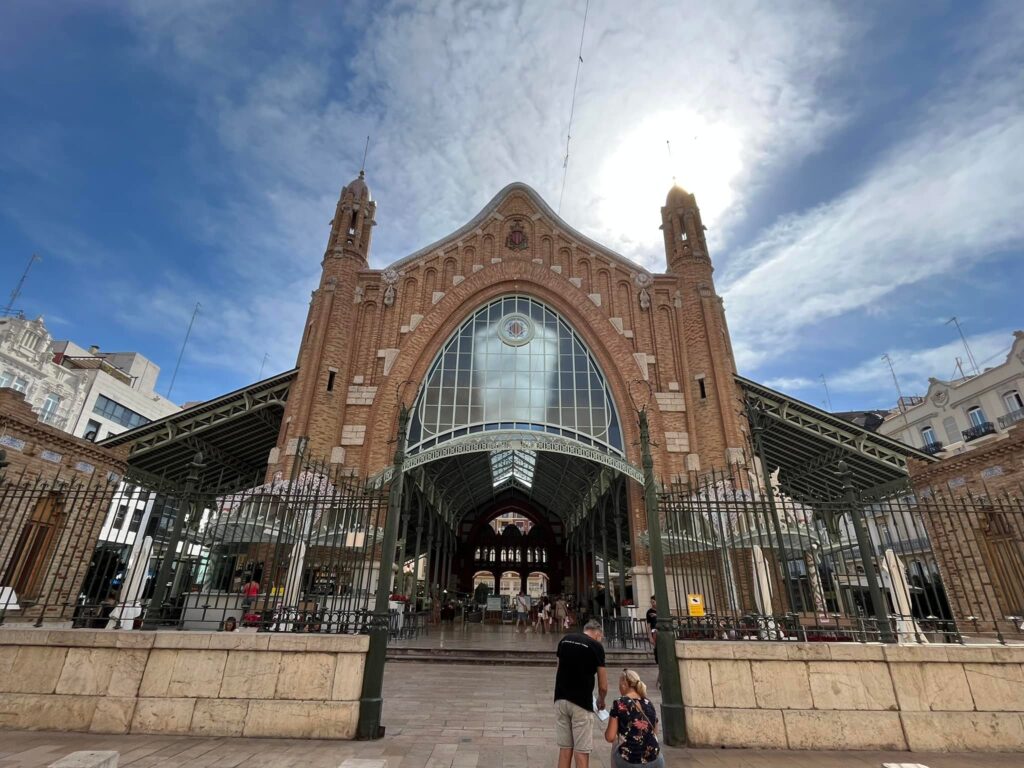
Mercado Colon. Completed in 1916, in times past it was a market, today it is home to flower stalls and some of the finest restaurants in Valencia. It’s a beautiful structure, especially when lit up at night!
Our time here in Spain has come to an end. We are incredibly grateful to have spent so much time getting to know this beautiful city. It was truly an unexpected stop in our journey and we tried to make the most of it. While we don’t have to go home, we can’t stay here. Our Visas are “expiring” and the weather window to cross the Atlantic is opening. On to the next adventure!!!
To see more pictures, check out our YouTube video highlighting the sites talked about here and more!